Chenonceau - le château des Dames
last update: 20 Nov. 2019
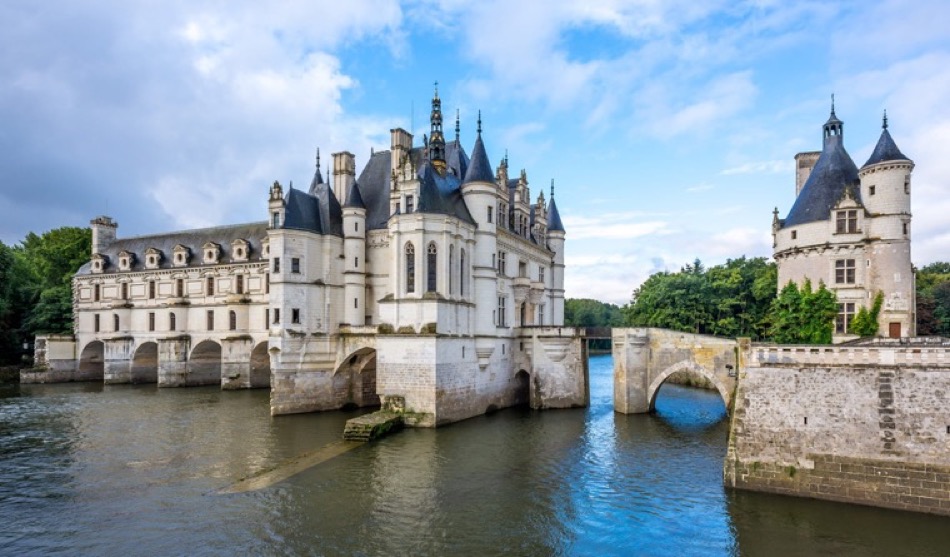
Introduction
Given all the wonderful options in the Loire Valley, how to decide which château to visit first? Not too far to drive. Not too overcrowded. Not too big. One that was interesting, and not just a ruin. Depending on the weather, look for a château that had some gardens.
We finally decided to visit Chenonceau, and it turned out to be an excellent first choice.

Here we have the two visitor guides that are often found on the Web. You can see that there is more to the visit than just the château with its formal gardens. In the grounds you have a 16th century farm, a park, and flower and vegetable gardens. With the restaurants and picnic area you can make the visit into a day out for the family.
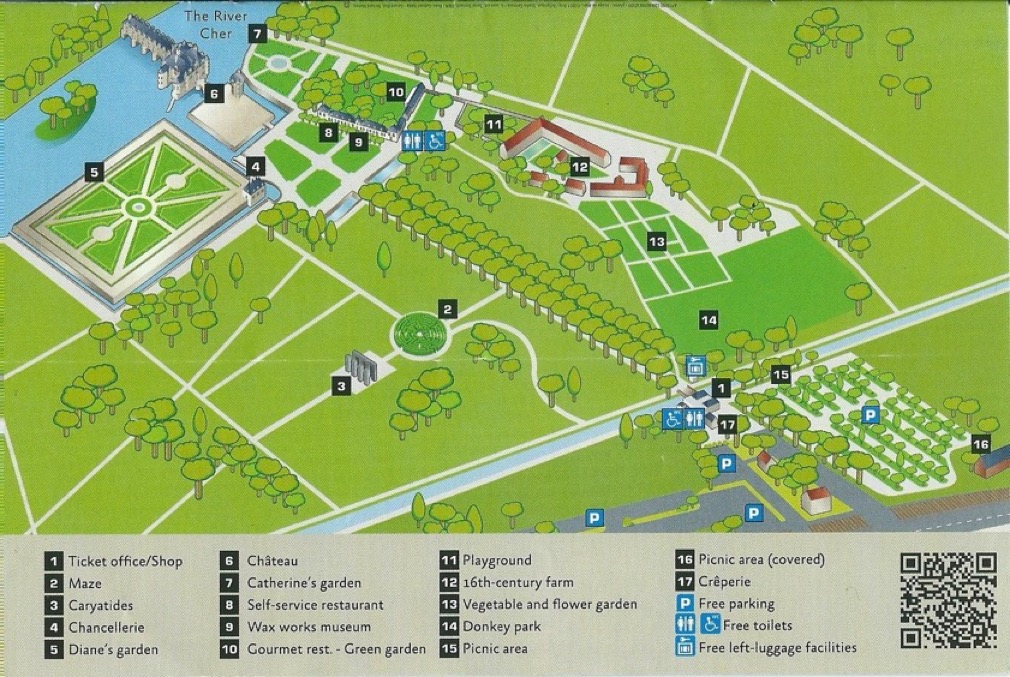
These two arial views of the château and the formal gardens gives us a clearer idea about the heart of the visit.

This château is often called the 'Château des Dames' or "the castle of the six ladies" for the succession of powerful French noblewomen who each had an impact on the castle as we see it today.

The history of Chenonceau is very well documented, and the site also has its own visitors guide, and there is also a separate guide on france.fr as well.
Early History
It would appear that the estate started as a fortified manor dating from 1230 (presumably to control the traffic on the River Cher). However in 1411 the manor was burnt and razed to the ground because of an act of sedition by the then owner, Jean Marques.
In 1432 Charles VII (1403-1461) finally authorised Jean II Marques to reconstruct the château. This took the form of a simple square stone fortress sitting in the River Cher, accessed by a short bridge or ramp, and with towers in each corner. The south-west tower is the only part of the building remaining, and the tower is now called the 'tour des Marques' (see below).
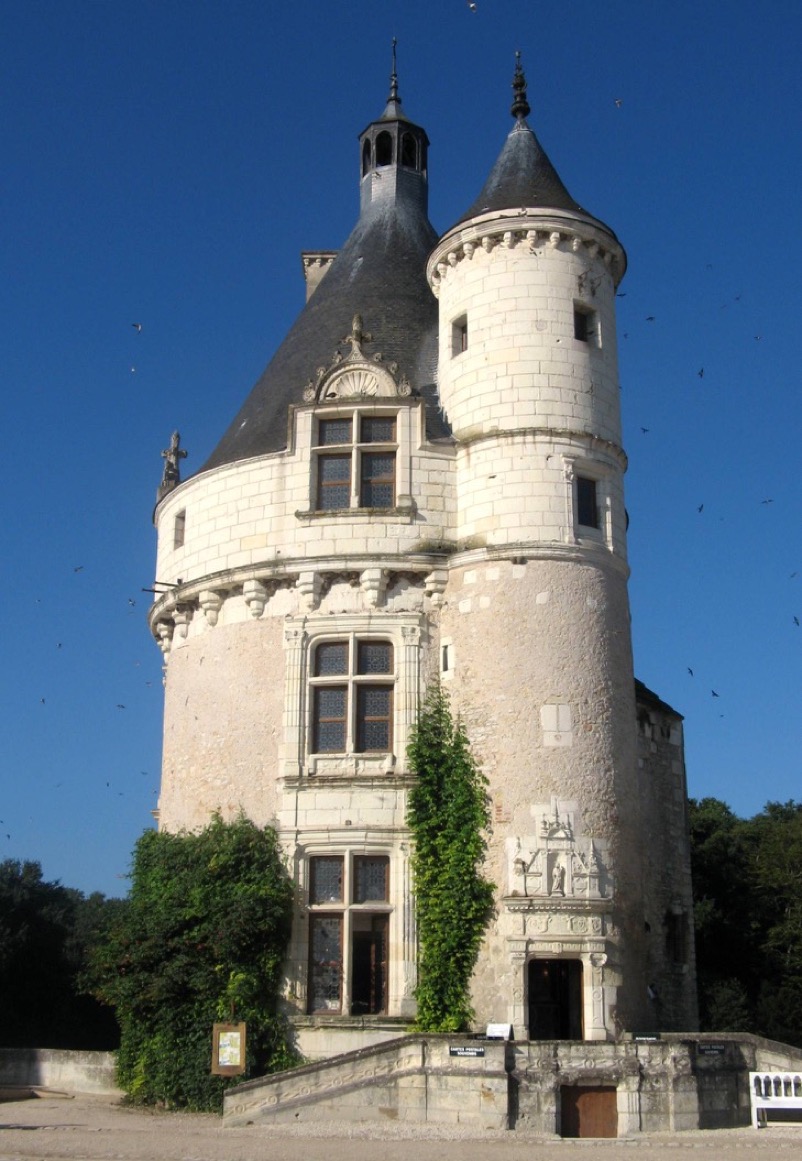
In fact Jean II Marques had obtained the authorisation after paying homage to Charles VII. We often forget that to 'pay homage' actually meant, in the feudal sense, to pledge reverence and submission as a vassal to a lord. In addition to building the fortress he also built a fortified communal mill on piers across the river.
In 1499 the family was in debt and had to sell Chenonceau. The purchaser was a certain Thomas Bohier (ca. 1460-1523). If you read the guide books, they will tell you that Bohier was a revenue collector for François 1er (1494-1547), and after the first sale the heiress to the château was able to buy it back, but finally had to sell the ruin back to Bohier in 1512. Technically correct, but far from the whole truth.
In fact Thomas Bohier came from a bourgeoise family and was a notary and 'maître des comptes' in Paris, this being a kind of auditor in the so-called 'chambre des comptes' which later became the 'Cour des Comptes' that controls the French public accounts. In 1491 he was appointed secretary to Charles VIII (1470-1498), then in 1494 he was responsible for the accounts of Grenoble, and in 1497 he was 'général des finances' for Normandy (he was also mayor of Tours in 1497). He finally became 'lieutenant-général' for François 1er and was 'trésorier général' for the Italian wars, where he died in 1523. So a powerful and rich man, and someone who 'exercised' that power and wealth to acquire Chenonceau.
Firstly using an agent it is said that Bohier started by buying properties and something called 'rentes constituées' which were loans made against property (in this case by the owners of Chenonceau). He then compelled the owner, Pierre Marques, to make the regular re-payments. In 1496 Bohier was finally de-masked, and he called in the debt of 352 livres and 1 measure of wheat. Marques could not pay and one story says that Bohier was able to buy the château for 7,374 livres tournois, but through a process called 'réméré'. This allows a sale, but also permits the owners, within a fix delay, to find new funds and buy back the property. However Pierre Marques was not able to make the re-purchase. Enter Guillaume Marques, the brother of Pierre, who evoked another legal option, the 'retrait lignager', which allows a direct member of the family to recover inheritable 'goods' which might have been sold and reimburse the purchaser. Upon the death of Pierre, his daughter took up this challenge, but after a lot of legal wrangling’s it was finally decided in 1512 that Bohier could make the final payment and take possession of the château. An alternative source mentioned that in 1506 the château was auctioned and bought by someone called Aymar de Prie (1453-1527). I presume that this was not what Bohier had planned, and this story goes that he went to court to cast down that decision. This story also mentions that in 1512 the château and lands were again auctioned, and this time bought by Bohier for 15,641 livres (it is suggested that this time Bohier bought-off Aymar de Prie from bidding against him on the château). Anyway we know that between 1506 and 1512 Bohier continued to buy fiefs in the region, and in 1514 he is able to join them all together to create a 'châtellenie' creating a single domain of about 1,600 hectares (16 square kilometres) over which he could rule more or less as he pleased (after having, of course, paid 'homage' to François 1er).
In 1515, Bohier demolished the castle-keep and the fortified mill of the Marques family, only keeping the donjon intact. He used the piles of the old mill as foundation stones for the new château, built in the middle of the river. The old castle became the esplanade we see today at the entrance to the château. As already mentioned one of the old towers was retained but it was later completely restored in the Renaissance style, from the windows with pilasters and pediments, to the decorated attic windows.
It should be said that Chenonceau was (and still is) not a very ample building, even including the extension built by Catherine de Médicis. Photographs tend to make it look bigger than it really is. It was designed as a 'maison de campagne' and not as a fortress, and in fact François 1er treated it as a hunting lodge.
Katherine Briçonnet
Given that Bohier was often away (in Italy for the war, etc.) it was his wife, Katherine Briçonnet (ca. 1494-1526), who took over the construction of Chenonceau. It is said that she greatly influenced the design of the building, for example building it in a 'Renaissance' style with the corner towers and monumental entrance. She also adding large, brightly light kitchens and Italian-style straight, wide stairs. The château and gardens were finished in 1522, and it is noted that François 1er twice stayed there.
Let's start the visit
It is perhaps time to have a look at some the elements first introduced by Bohier and his wife.
So we have parked the car, got our tickets at the entrance, and walked up the tree lined 'allée d’honneur' with the maze on the left and the vegetable and flower gardens on the right.
And out we come in front of the formal entrance to the château.
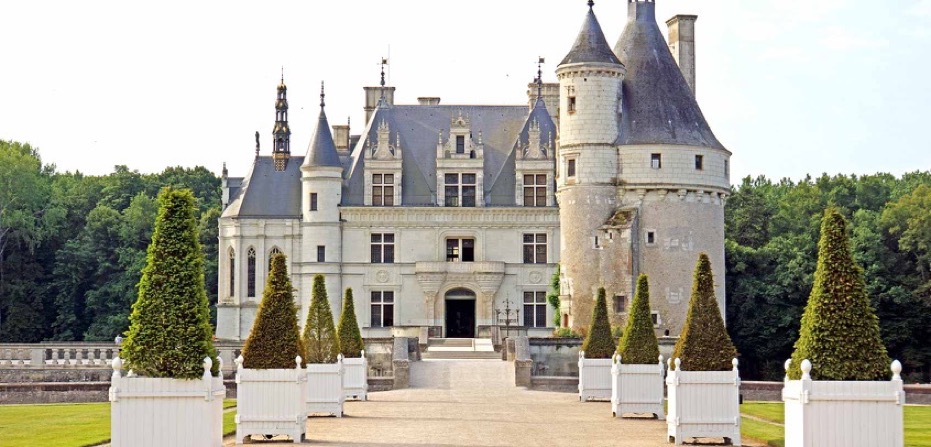
We can see nearer to us on right the older 'tour des Marques' and behind that the front façade and entrance to the château. And below we can see more clearly the château, the 'old tour' and the esplanade made from the foundations of the original castle.
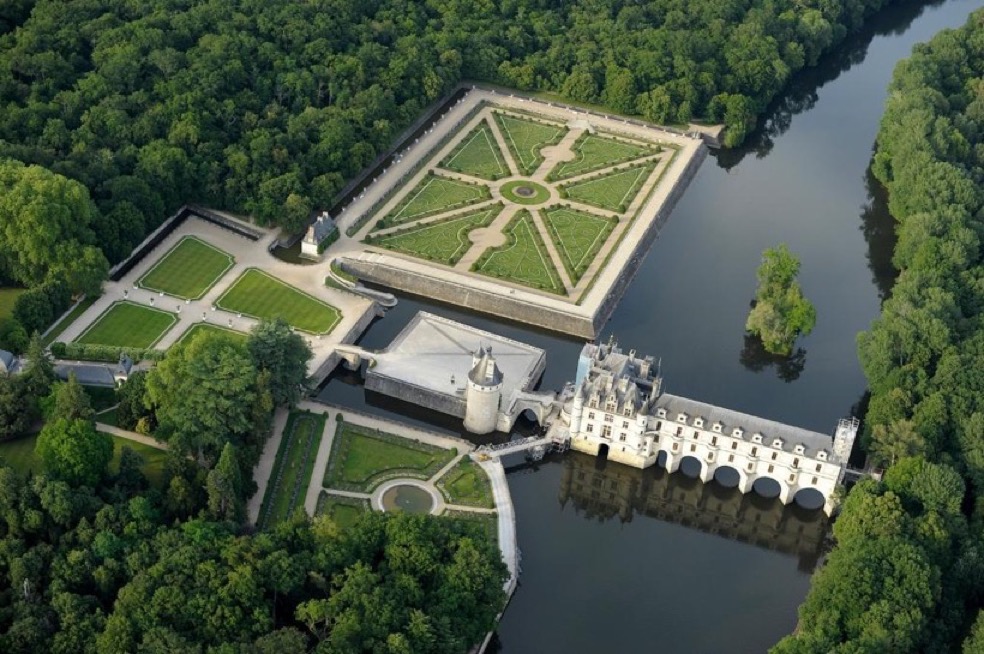
Below we have stepped forward onto the esplanade. What we see (also with the renovations made to the 'tour des Marques') is a Renaissance take on a medieval look. There is an attempt to look 'solid', almost military, and to avoid over-decoration. The round corner towers echo the medieval drum towers, which often (but not with this château) housed staircases. And the pointed roofs echo those found on top of corner turrets.
Here we are in the purely decorative, since originally in order to house the spiral staircase drum towers were usually wider than their overall height, and turrets were small medieval towers or defensive projections sitting on corbels and hanging from the corners of buildings.
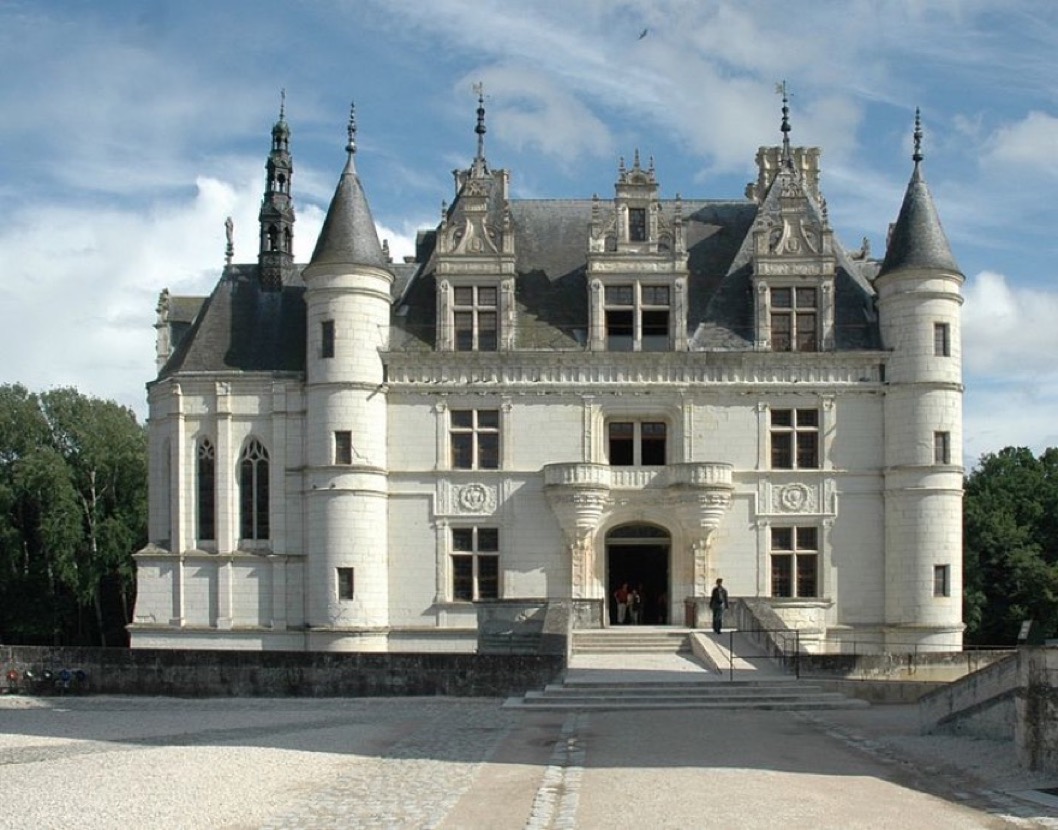
You can also see the 'modern' (i.e. not medieval) use of large windows to bring a lot of light into the rooms. The symmetry and regularity of the façade around a vertical axis, the central entrance, and the decoration on the windows (particularly those in the roof) highlight the Italian influence. Firstly the central pillar in the windows, then the motifs set on a cornice, and the abundant ornamentation particularly around the upper rectangular skylights, all underline the verticality typical of Renaissance architecture. The lack of semi-circular window tops and oval windows points to an early Renaissance inspiration.
The Ground Floor
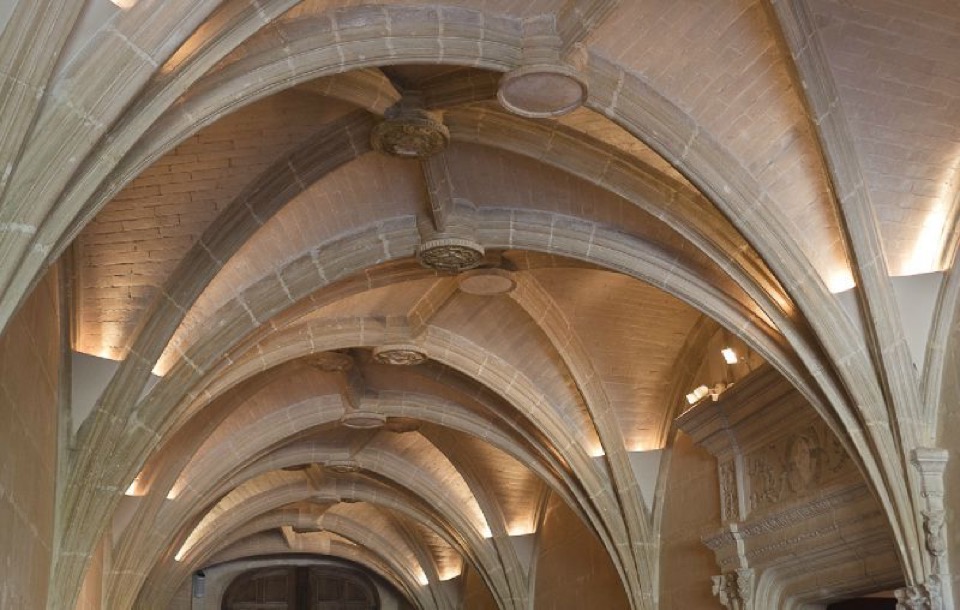
The hall, said to be designed by Katherine Briconnet, was built in 1515 and is covered with a series of rib vaults whose keystones, detached from each other, form a broken line. This very unusual structural innovation is considered one of the most beautiful examples of decorative sculpting from the French Renaissance period.
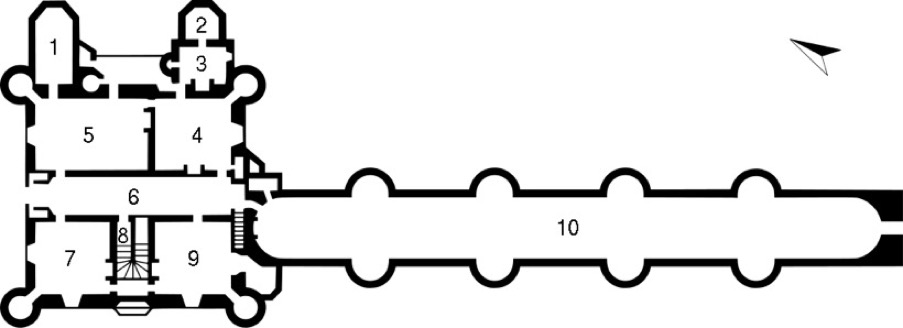
The hall (or 'vestibule') leads to four rooms (no.6). On the left we have 'La Salle des Gardes' (no.5) with its access to the chapel (no.1), and the 'Chambre de Diane de Poitiers' (no.4) which also leads to a small 'Cabinet Vert' (no.3) and beyond that to a small library (no.2). On the immediate right we have the 'Salon Louis XIV' (no.7) and further back on the right we have the 'Salon François 1er' (no.9). Between these two rooms we have the stairs (no.8) leading up to the first floor. You can also just about see the small stairs leading down to the kitchens.
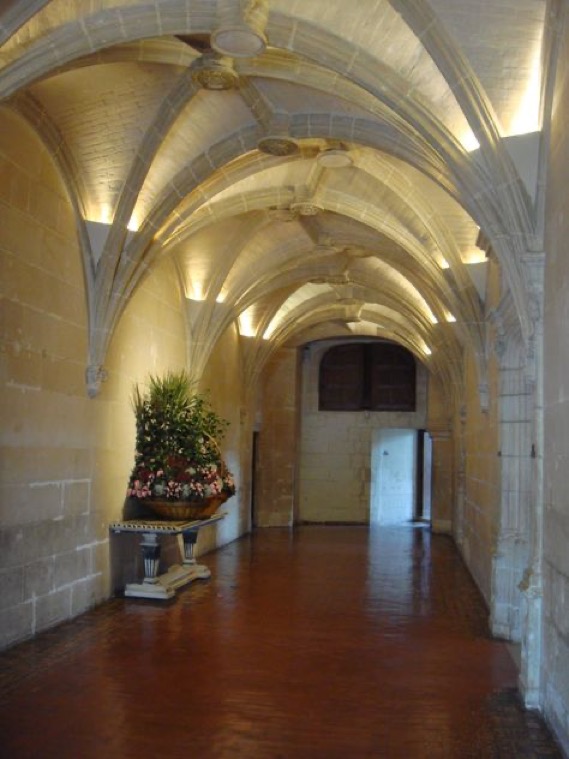
At the end of the vestibule we have a smallish entrance to the gallery (no.10), and there is also a second private entrance to the gallery directly from the bedroom of Diane de Poitiers. We will return to this architectural addition later.
The first room on the left is the 'Guards Room' (no.5), today it is the entrance room to the château where you can pick up the audio guide.

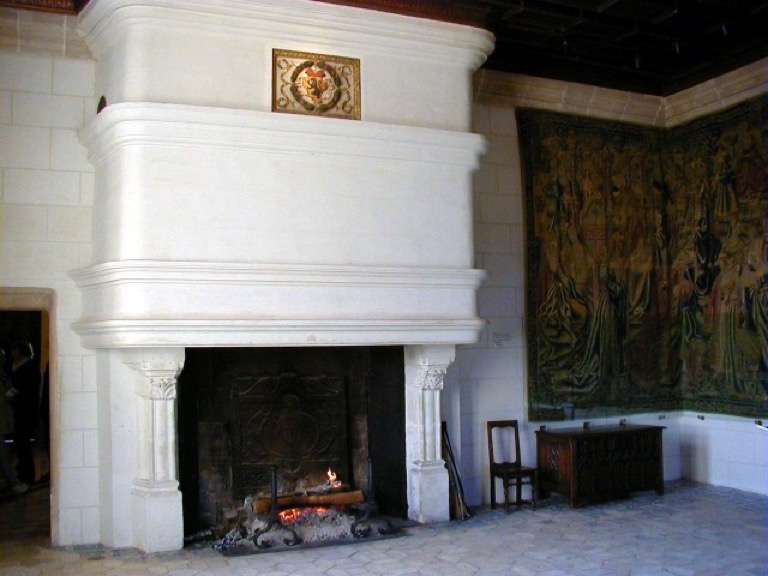
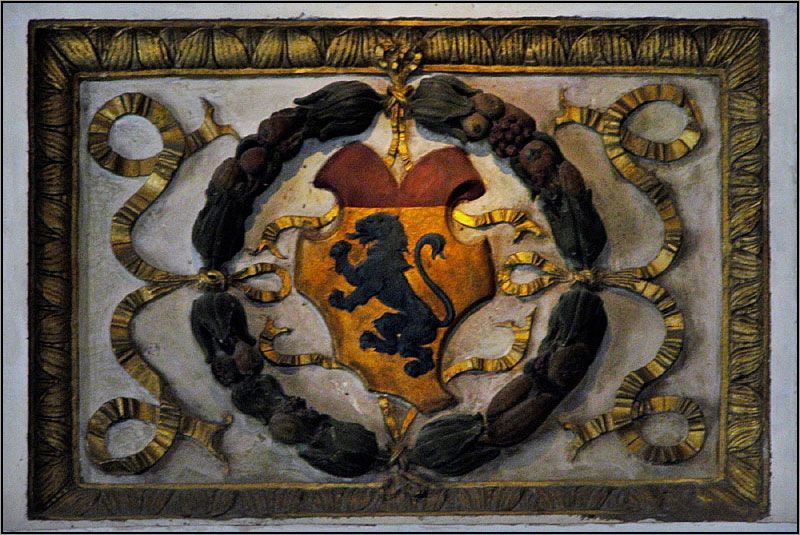
It is my understanding that a guard room was often placed next to the bedroom of the most important person living in the château, presumably to provide constant protection. Not the most elaborate of the rooms in the château, but it has a monumental chimney with the arms of Thomas Bohier, 16th century Flemish tapestries on the walls, and a wooden ceiling with exposed joists which is said to be typically French.
We can see in this room something of the furniture of the period. The court would move from one royal residence to another, and they would take with them their tapestries and their silverware and crockery in strong wooden chests.
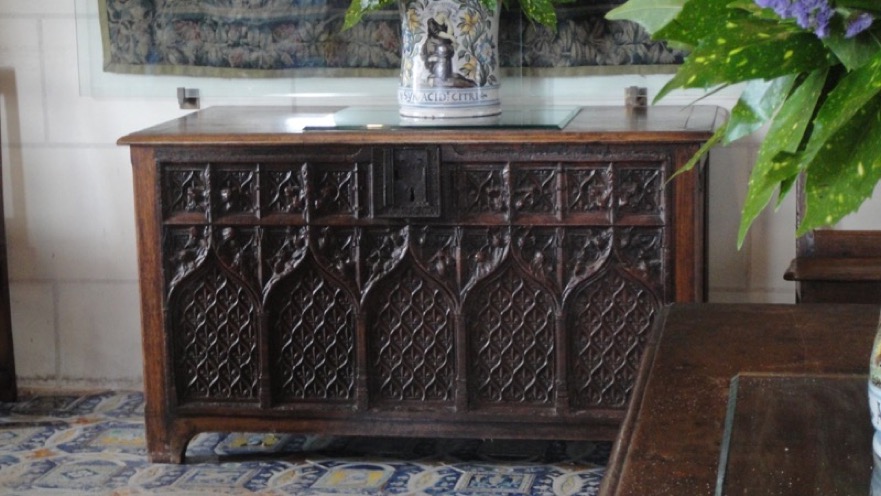
These particular tapestries show scenes of castle life, a marriage proposal, and a hunt, and would have been hung on the walls as winter insulation.
We can also see in the guard room the best examples of the original floor tiles.
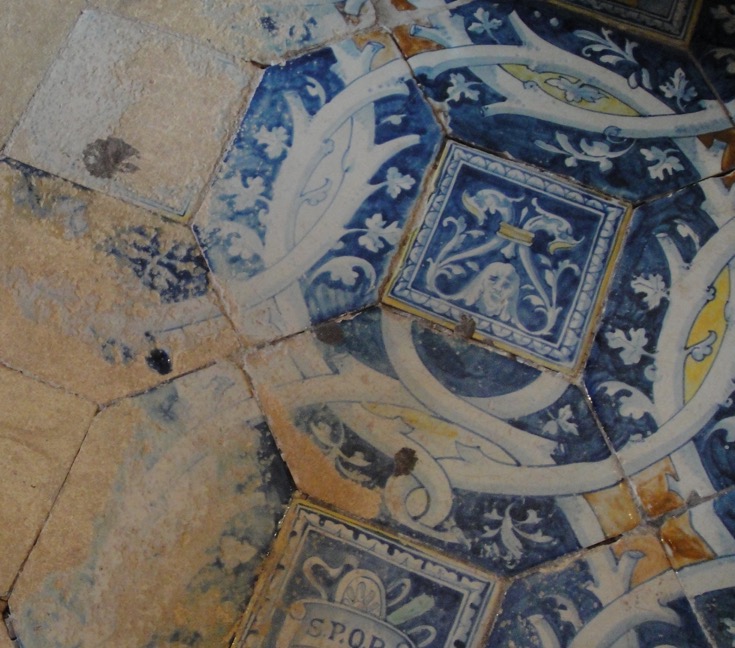
In the early 20th century this guard room was used as a dining room, which many thought was incongruous in that it led to the chapel.
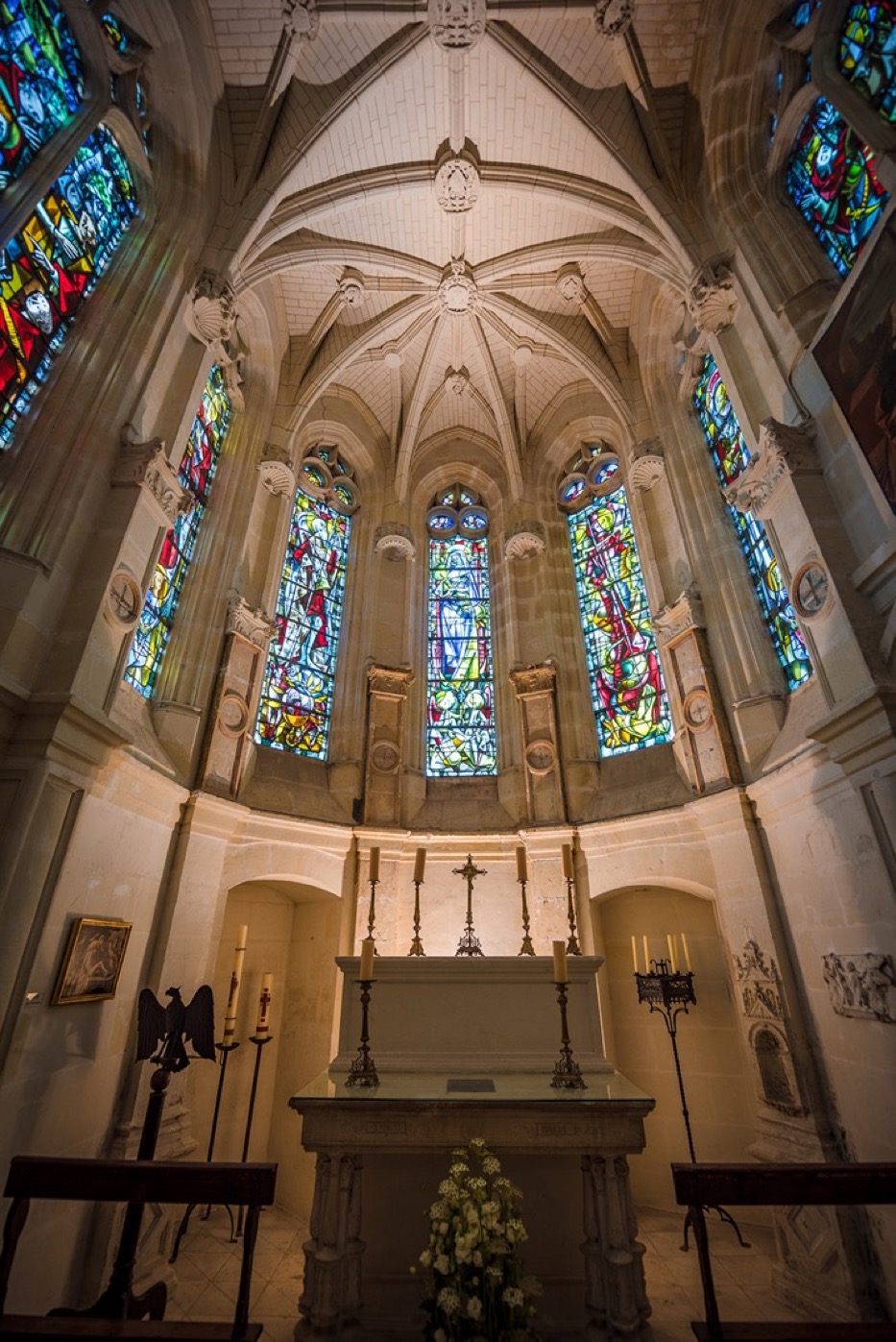
Leading from the guard room is a small chapel (no.1), consecrated by Cardinal Bohier, a relative of Thomas Bohier. In the guide books it looks quite large, but the reality is that it probably could not seat more than 20 people. The original stained glass windows were destroyed by bombs in 1944 and were replaced by the works of Max Ingrand, a master glassworker, in 1954. Overlooking the nave on the first floor is a royal tribune where the Queen would sit during services.
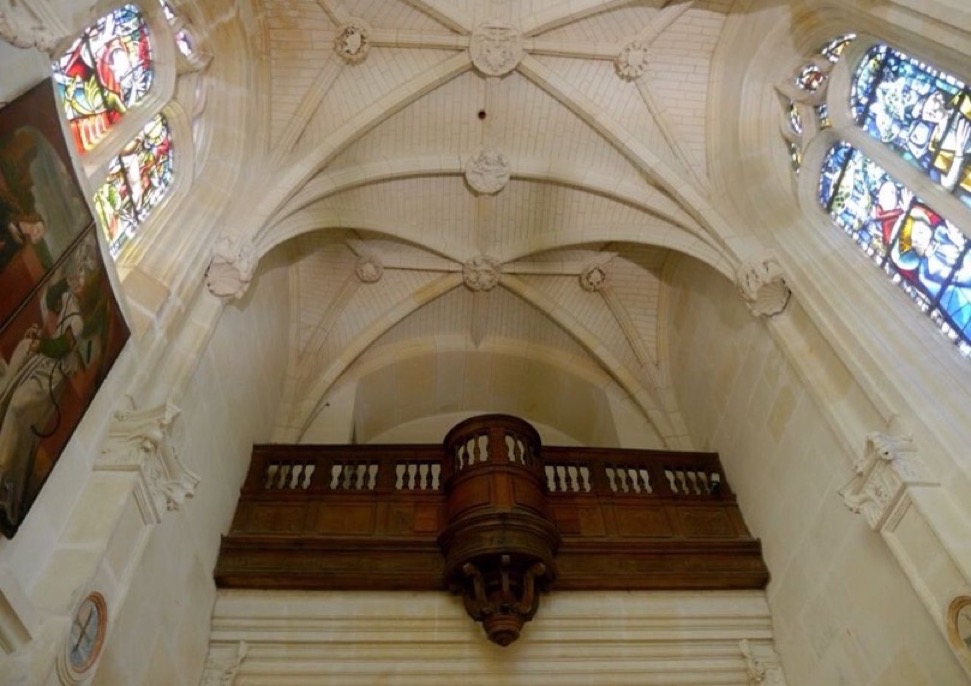
One nice bit is that you can still read the inscriptions on the walls left by Queen Mary Stewarts Scottish guards: On the right as you enter, dated 1543 “Mans anger does not accomplish Gods Justice” and 1546 “Do not let yourself be won over by Evil”.
There is a story that during the French Revolution this chapel survived vandalism because the lady of the house filled it with firewood. Angry masses looking to smash anything royal or religious only saw stacked wood.
To understand a bit better the next rooms we are going to have to continue our walk through the history of the château, and in particular the impact that its many women 'owners' had on it.
Chenonceau becomes a royal residence
Again different versions overlap, but are not identical. One version says that after the death of Thomas Bohier in 1523 (or 1524 depending upon the version) his wife Catherine Briçonnet and their son Antoine completed the construction in 1526. But in a different version it also said that François 1er twice slept there after the château was finished in 1522. It would appear that Catherine also died in 1526, and Antoine Bohier inherited Chenonceau. One story mentions that after an audit of the accounts it was found that Thomas Bohier had embezzled some money (not clear from whom). Another story simply mentions debts. Yet another account mentions an investigation into the finances of Jacques de Beaune-Semblançay (ca. 1465-1527), a relative of Bohier, but that both were accused of embezzlement. In any case a fine of 190,000 livres was imposed on Antoine by François 1er. One rather detailed version of the story tells us that François 1er accepted the lands of Antoine Bohier, including Chenonceau as part payment, the equivalent of 90,000 livres. Other lands were counted at 19,000 livres, and there was an agreement to pay an additional 41,000 livres. The remaining 40,000 livres was set aside by François 1er in recognition of the services rendered by the Bohier family. So Chenonceau became a royal residence.
Naturally with a debt hanging over the Bohier family they did not bother to repair or maintain the château. It is said that what finally was handed over to François 1er was little more than an abandoned shell emptied of anything valuable. François 1er made Maréchal Anne de Montmorency (a man) responsible for the château, and it was placed in the hands of the local mayor of Tours, Philibert Babou de la Bourdaisière. To the surprise of many François 1er did nothing for the renovation or upkeep of Chenonceau. Probably understandable because he was at that time building both Chambord (started in 1519 and work continued through until at least the death of François 1er in 1547) and Fontainebleau (started in 1528 with the nomination of the first 'conducteurs de travaux'). However there is mention of François 1er staying at the château whilst hunting. Once François 1er was dead, his son Henri II (1519-1559) almost immediately gave Chenonceau to his “favorite” Diane de Poitiers (1500-1566).
This sounds very simple, but it hides a complex and very informative story.

Diane de Poitiers
Diane de Poitiers (having no link to the comtes de Poitou) was born in 1500 into a family close to the then king. She was orphaned at six, and spent her formative years with Anne De Beaujeu, oldest daughter of Louis XI (1423-1483). At the age of 15 she married Louis de Brézé, grand-son of Charles VII (1403-1461). Despite her husband being 55 at the time, she gave him two children (it is now known that she also had other children). Her father, Jean de Poitiers, was accused and found guilty of treason along with Charles III de Bourbon, but this clearly did not stop her because she became maid of honour firstly to the famous Reine Claude (1499-1524) who married François 1er, then to Louise de Savoie (1476-1531) the mother of François 1er, and finally to Éléonore de Habsbourg (1498-1558) a later wife of François 1er.
When her husband died in 1531 she almost immediately demonstrated to have a good head for finances, and she managed to protect and even prosper her fortune. It is said that she was both intelligent and a very healthy, robust, athletically toned woman. There is no solid proof that she was at anytime the mistress of François 1er, but it is true that he certainly helped her retain control of her husbands assets.
In 1525 the dauphin François, the oldest son of François 1er, and his younger brother Henri (future Henri II) were 'hostaged' to Charles Quint in return for the freedom of François 1er. In fact François 1er had lost a battle in Pavia and was made prisoner. He was freed but had to agree to marry Èléonore de Habsburg, and hand over his two oldest sons for the following four years. Diane de Poitiers had been in the group that accompanied the children (ages 8 and 7 at the time) to the frontier, and later had been charged with the education of Henri upon his return four years later. It is said that Henri was a rebellious youth, insolent and rude, and it was Diane de Poitiers who taught him the necessary graces and refinement for the court.
Diane de Poitiers was a cousin of Catherine de Médicis (1519-1589) and had supported her marriage to Henri d’Orléans in 1533 (both were 14 at the time). It is generally thought that Diane de Poitiers became the mistress of Henri around 1538. She was 38 years old, and Henri was 19. At the court centred at Fontainebleau, Diane was the embodiment of respectability and champion of religious orthodoxy. One expert noted that never was a widow seemingly more loyal to a husband's memory, yet no mistress ever exercised a firmer control over a lover.
Henri became Henri II de France in 1547, and Diane de Poitiers, to all intents and purposes, became the most powerful woman in France. She kicked out the old 'favourites', took their gifts, received a hôtel Parisien and other lands and gifts including Chenonceau in 1547. She became Duchesse de Valentinois and was allowed to sit even in the presence of the Queen. Her daughter, Françoise de Brézé, became maid of honour and ended up running the household of Catherine de Médicis. Diane de Poitiers had rooms near the king, with a salon and chapel, privileges normally reserved for people of royal birth. Concerning Chenonceau, Diane de Poitiers ran a prosperous estate with unmistakable authority, and with the receipts from the farm produce, royalties from vassals and fines imposed by the castle court she managed to balance the château’s budget.
Obviously one could write much on the relationship Diane de Poitiers had with Henri II, and with his queen Catherine de Médicis, but this is not the place. Our topic is the Château of Chenonceau, and there is just one last element worth noting. Many of the guide books tell us that upon the death of Henri II in 1559 Catherine de Médicis moved into Chenonceau, and sent Diane de Poitiers to Anet, the property of her defunct husband Louis de Brézé (Henri II had ensured that Diane kept control of Château d'Ante). The implication is that Catherine took revenge on Diane, just as Diane had done on the mistresses of François 1er. There is much to suggest that this was not the case. No sanctions were taken against Diane de Poitiers by the royal family. Naturally she had to return the jewellery listed in the royal inventory, and she and her daughter were no longer welcomed at court. However she retained the lands and assets of her defunct husband. And Catherine, whilst taking Chenonceau, offered Diane Château Chaumont, which was financially far more attractive. Some have noted that Diane was not at the deathbed of Henri II, nor was she seen during the funeral. Again this is easy to understand since Henri II would have renounced all sin and guilt (including his mistresses), thus being in a state of grace and ready to enter heaven.
We continue the visit
Now that we understand a little better the character and role of Diane de Poitiers, we can visit her bedroom (no.3). The guide books enjoy telling us that the room is elegant and that the bed 'à baldaquin' dominates. The two items that stood out in my mind were the magnificent white chimney with the royal symbols in pure gold and the 16th century Flemish tapestries.

The chimney and the ceiling carry the initials of Henri II and Catherine de Médicis interlaced, but the 'H' and the 'C' appear to form a 'D' for Diane.

Many of the guide books note that it was understandable that Catherine de Médicis wanted to impose herself on this room by later placing her own portrait over the chimney. I understand that the portrait was made by Jean Goujon, a Mannerist painter of the Fontainebleau School, and much inspired by the Italian sculptor Cellini.
But I'm not convinced since some old photographs clearly show that the painting hides a far more royal statement. I have found no references to explain the difference between the chimney of old, and the one we saw now in the bedroom.
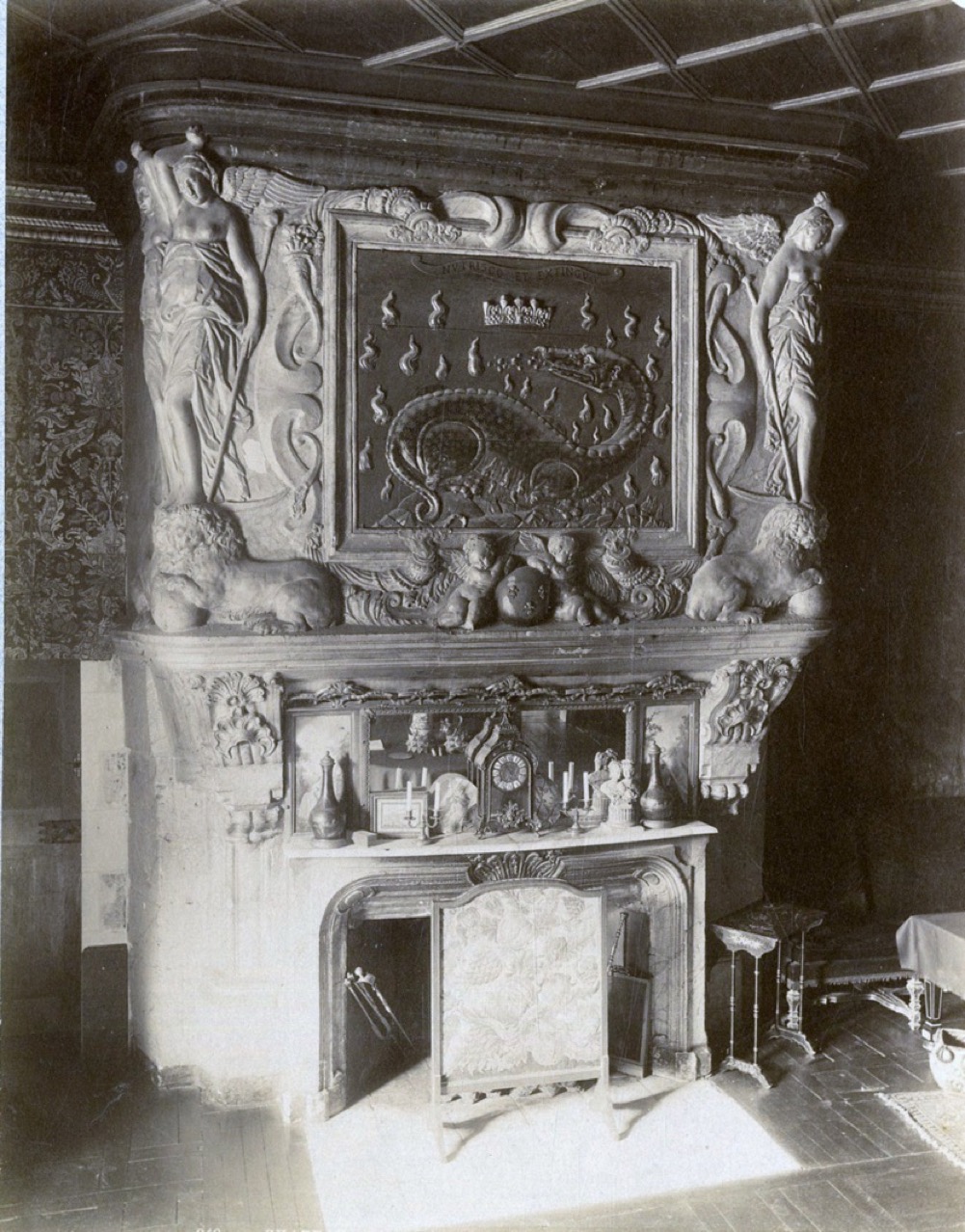
Tapestries are difficult to appreciate but the two in this room are masterpieces, representing 'Le Triomphe de la Force' and 'Le Triomphe de la Charité'. The colours are still quite strong, so you can imagine how vibrant they must have been 400 years ago. We really have to sit back and imagine that these were woven by hand on a simple loom, yet the Flemish weavers were still able to produce an extraordinary range of surface textures and 'painterly' effects. In most cases these tapestries were copied from large 'cartoons'. We must remember in Renaissance times a cartoon (from the Italian cartone or large piece of paper) was a full-sized preparatory design for an artwork to be made in another medium, e.g. fresco or tapestry.
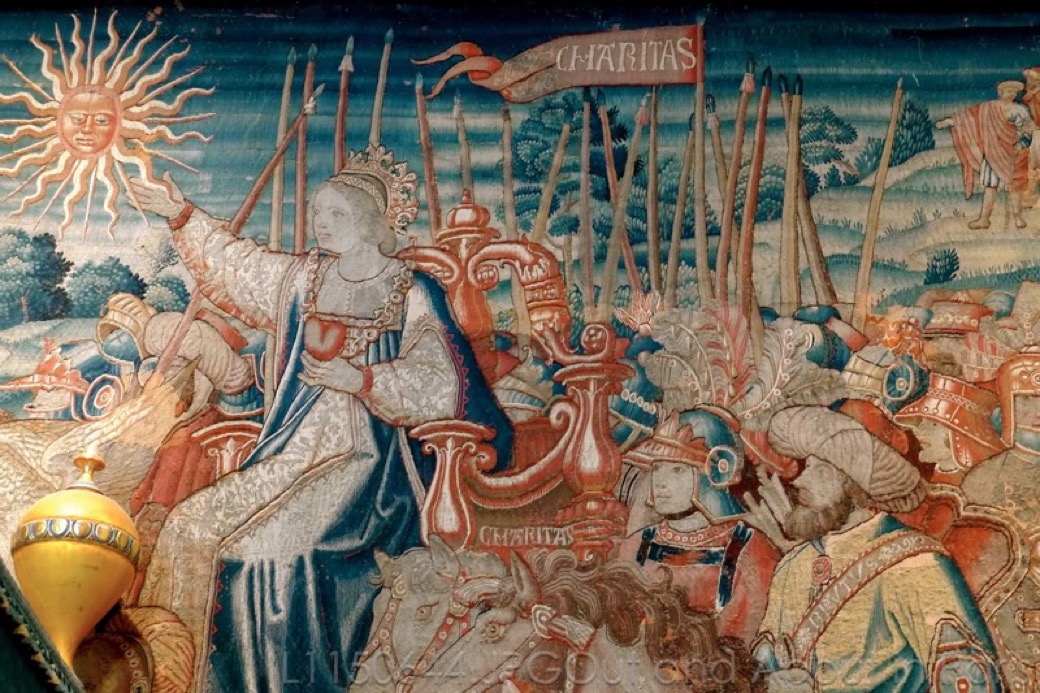
It was recently estimated that each of these tapestries would have taken in excess of 60 person-years to create.
Attached to this bedroom is the 'Cabinet Vert' (no.3), or the Green Room, said to be the study of Catherine de Médicis. Tradition has it that she governed France from this small room.
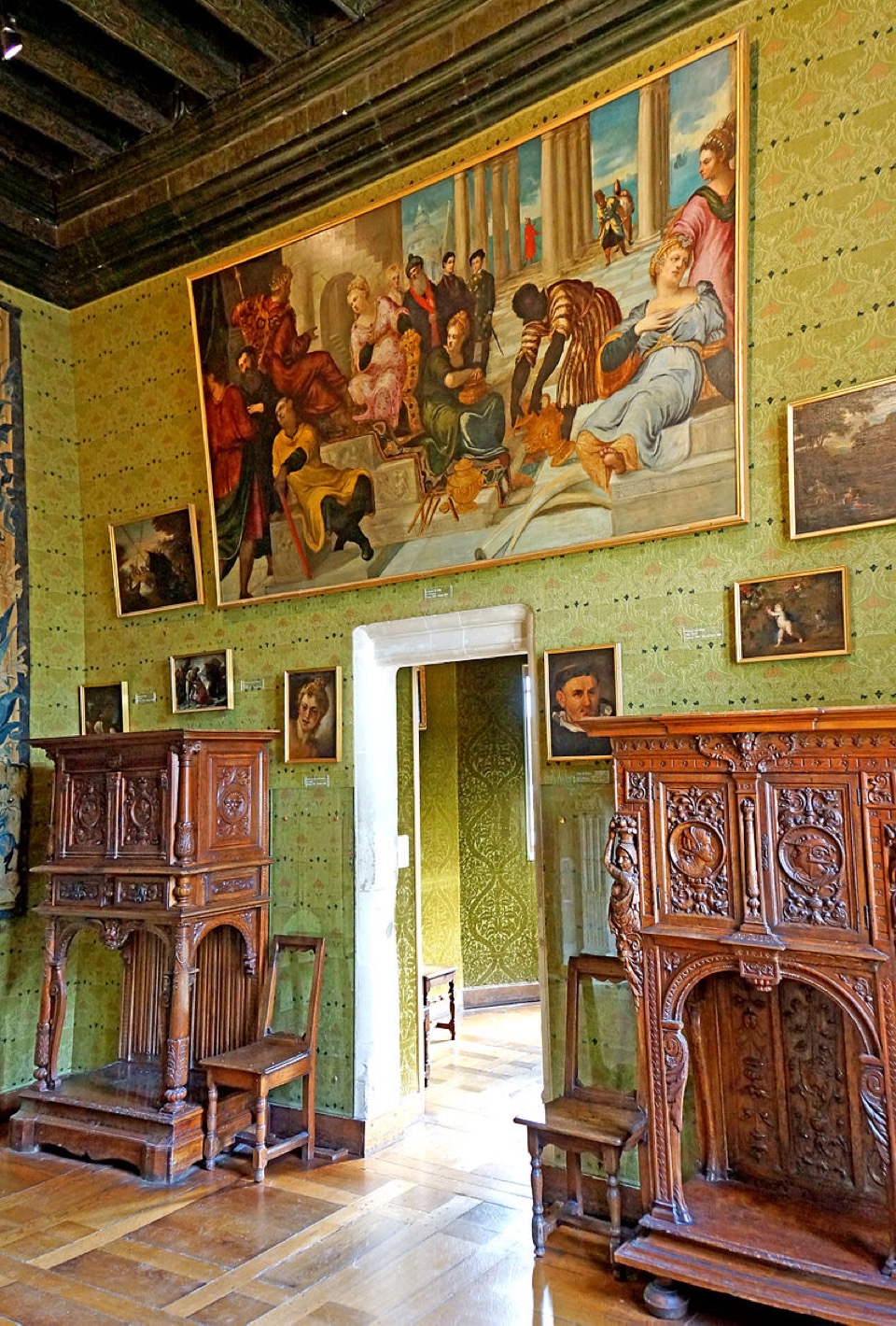
And attached to the 'Cabinet Vert' is an even smaller room called the library (no.2), which is where Catherine de Médicis had her desk.
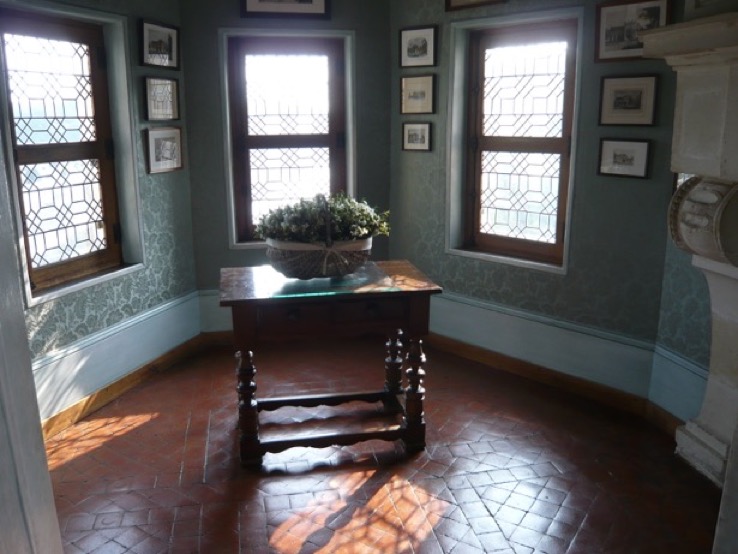
The most notable things in this room are the coffered ceiling and the views over the river and gardens. The oak coffered ceiling is Italian-style and dates from 1525. With the small hanging keys, it is said to have been the first of its type known in France. It clearly dates from the time of Thomas Bohier and Katherine Briçonnet because their initials 'T.B.K.' are carved in the wood.
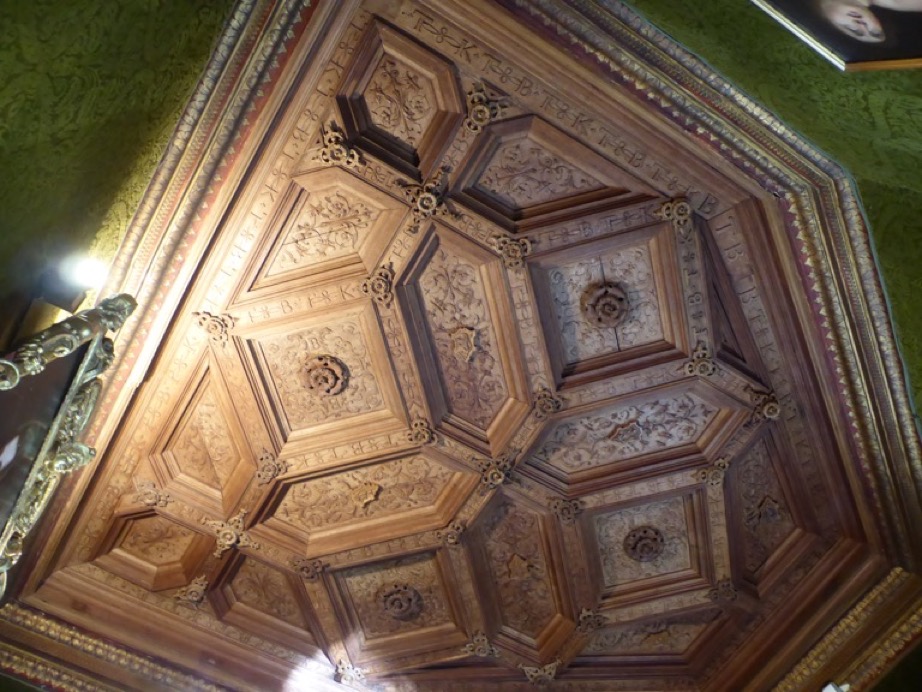
This type of ceiling with beams and cross-beams was often used in the château’s of the Loire Valley, but it actually has its origins in the stone coffers of the ancient Greeks, and was reused during Roman times, e.g. wooden coffer ceilings have been found in Herculaneum. The coffer ceiling is also a feature of both antique Islamic and Chinese architectures. The reference to 'hanging keys' is just those central 'keys' placed at the joint of the cross beams, and which in this case hang down so that they can be elaborately decorated.

From the library we can also see the River Cher, and 'Diane’s Garden' with its eight triangle sections and central fountain.
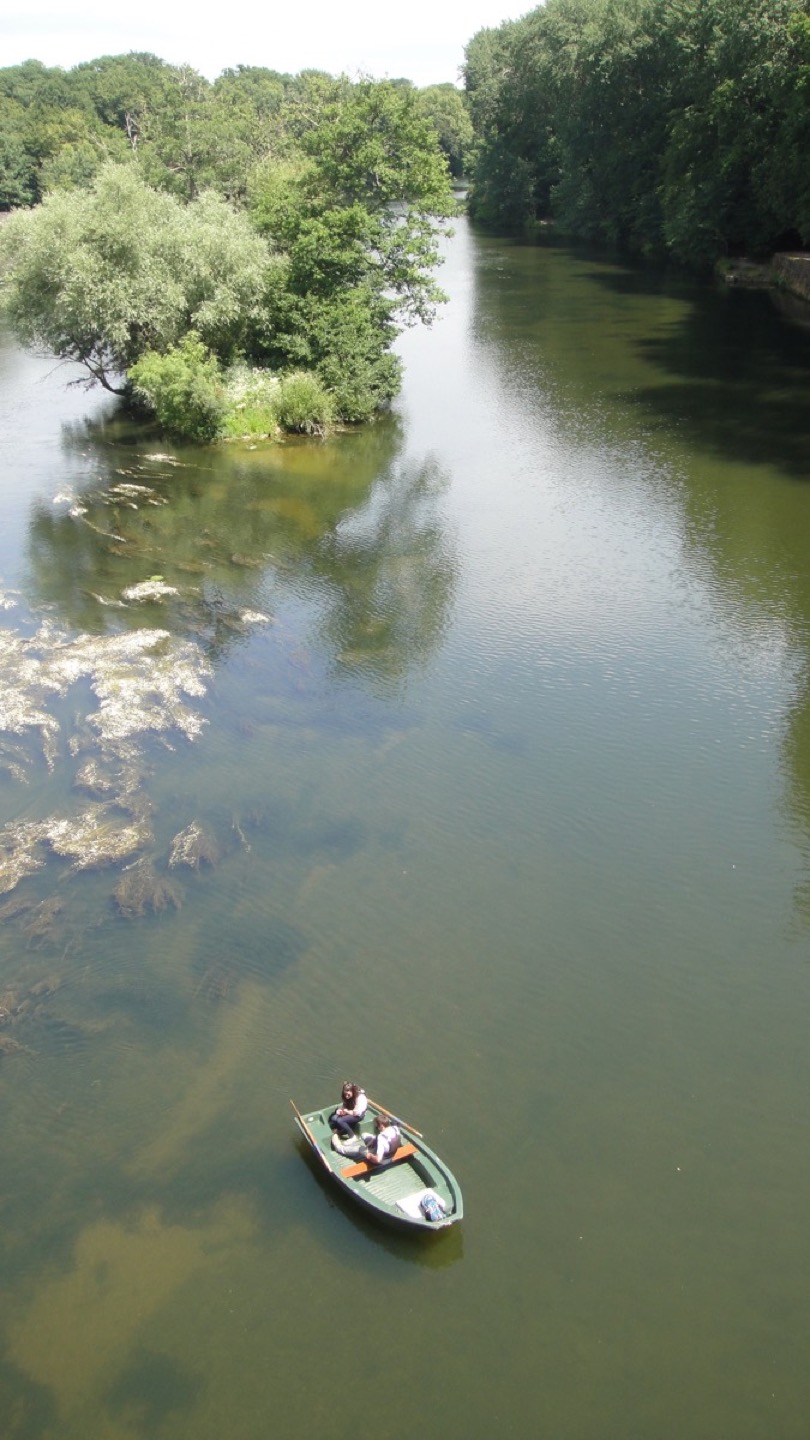
Catherine de Médicis would have seen a different 'Diane’s Garden' from the one we see today. The current X paths were only introduced in the 19th C, and at the time the gardens were planted with hawthorn and hazel bushes, along with peach and apple trees, and wild strawberries and violets. At one time, but I'm not sure when, it is said that 'Diane’s Garden' was planted with several hundred white mulberry trees for the cultivation of silkworms.
The château guide normally would take us now to 'La Galerie', but I will first visit other parts of the ground floor and the kitchens.
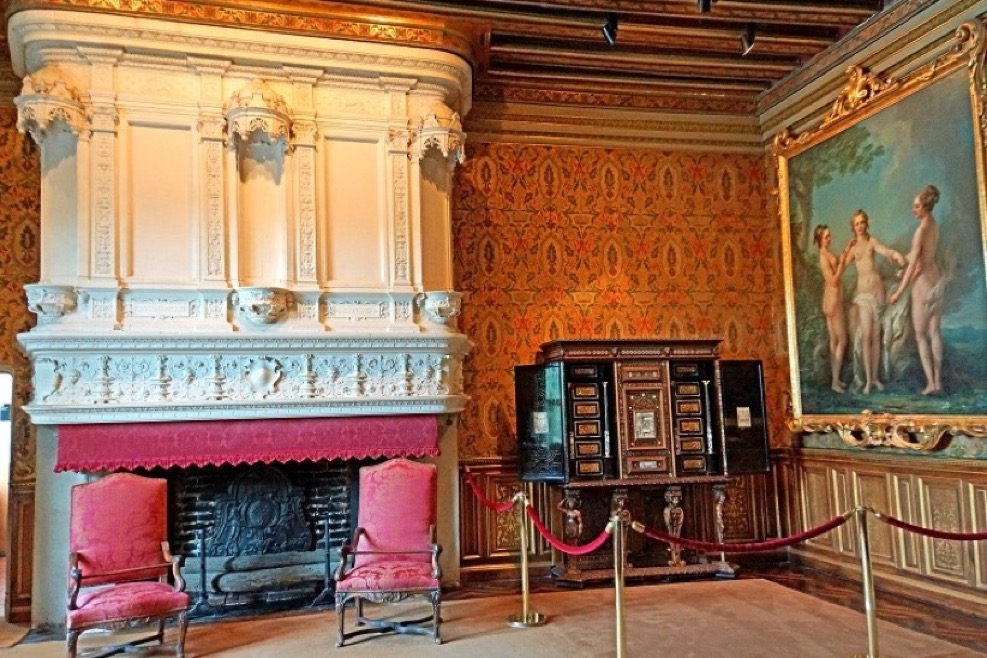
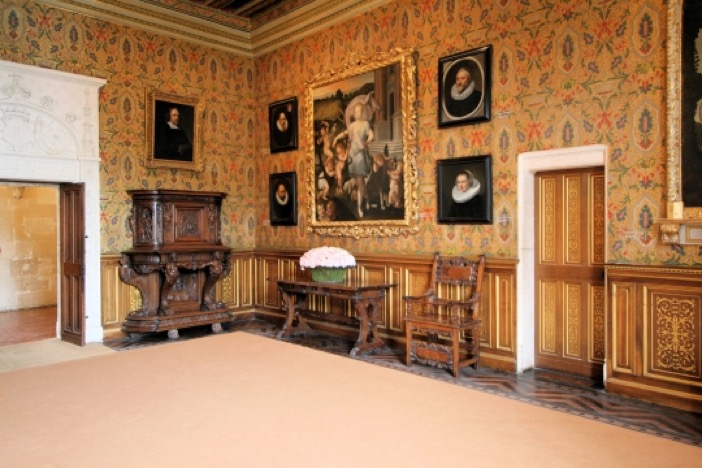
So let us move to the 'Salon François 1er' (no.9) with its magnificent Renaissance chimney. You would not guess it, but Chenonceau was for about 12 years (1535-1547) a 'simple' hunting lodge for François 1er, and even then he did not use it much.
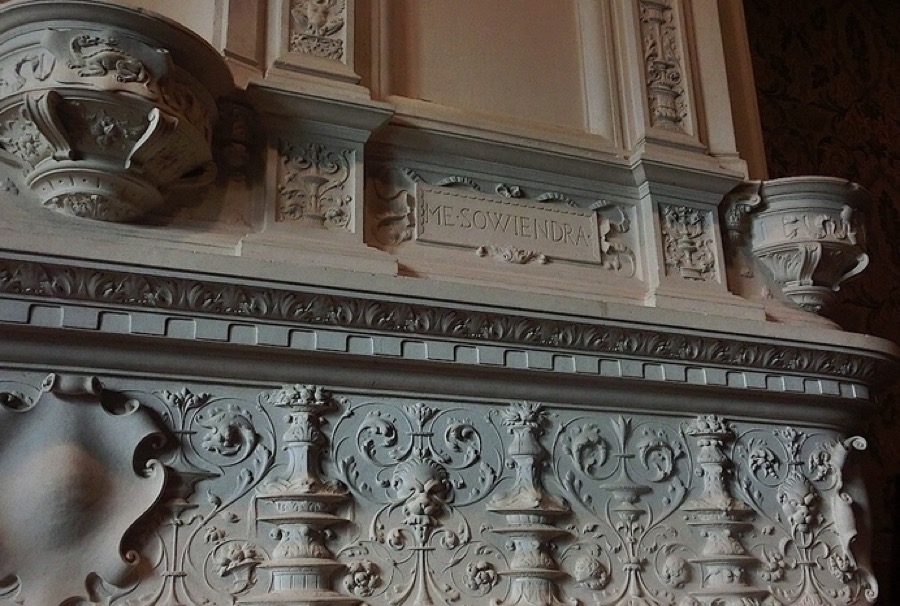
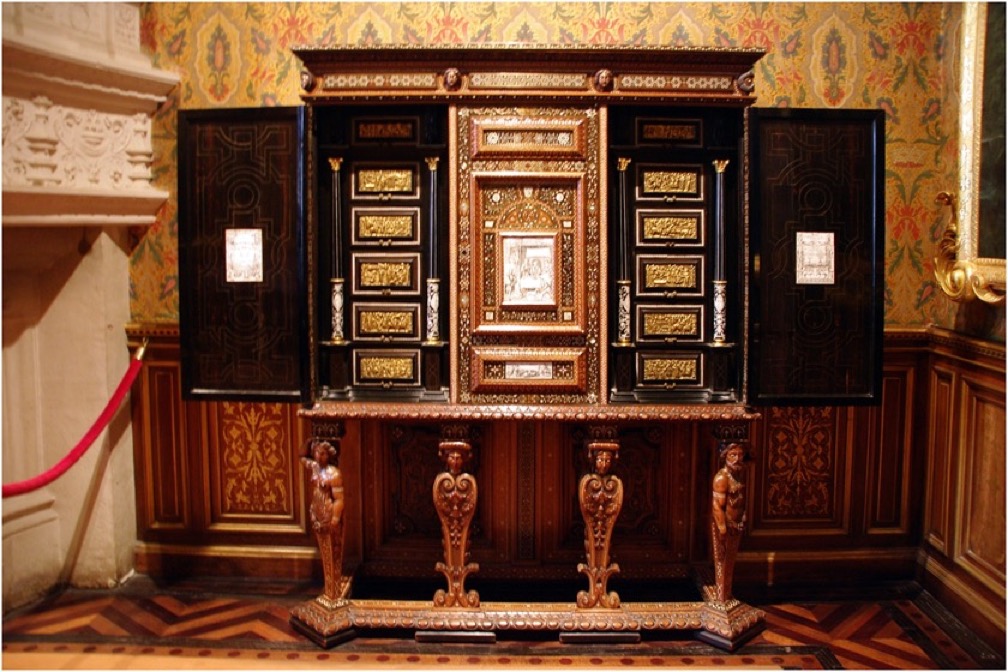
We were both very much taken by an 16th century Italian cabinet incrusted in ivory and pearl which was offered to François II upon his marriage to Marie Stuart.
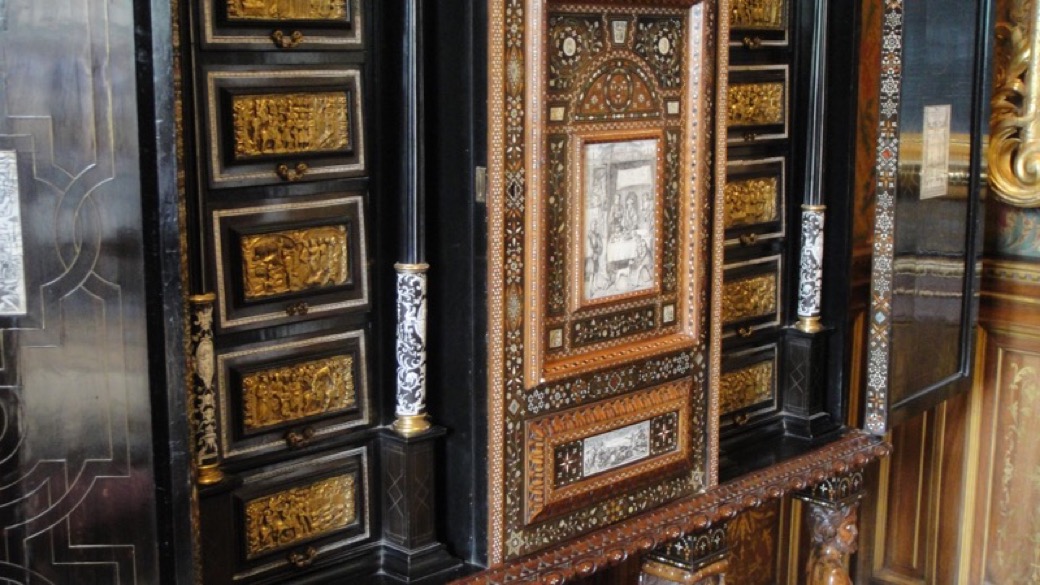
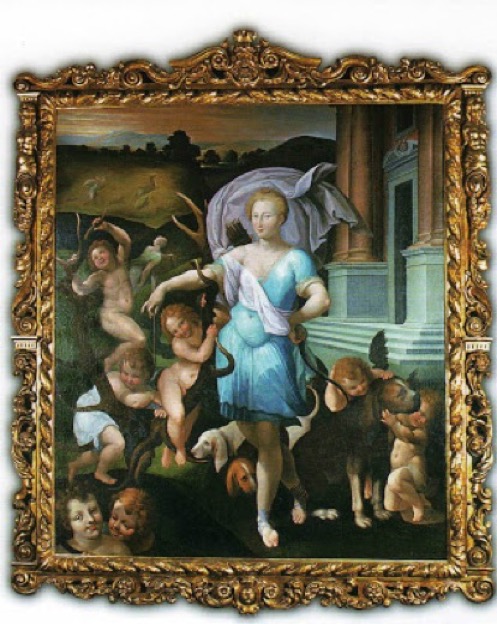
Hanging in the room there are a couple of paintings worth noting. This one is a portrait of Diane de Poitiers as 'Diane Chasseresse' (Diana, the goddess of the hunt) by the Italian painter Le Primatice (dated 1556), and said to have actually been painted in the château.
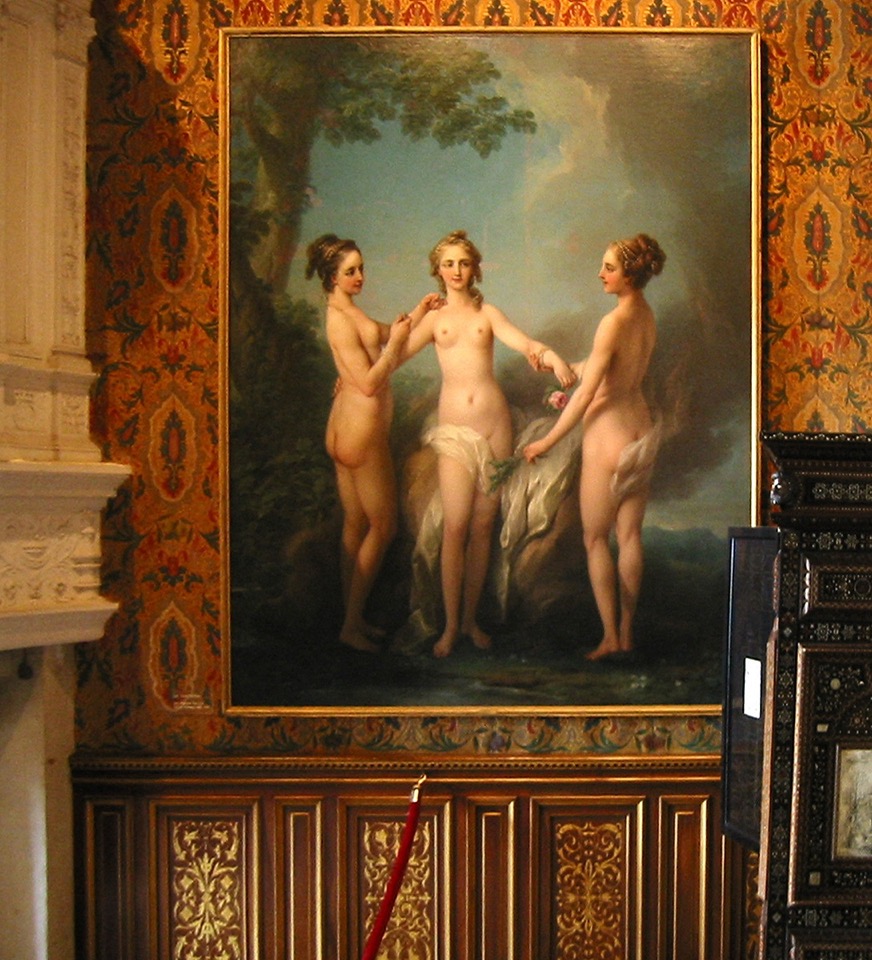

The other is the 'Les Trois Grâces' by the French painter Carle van Loo (dated 1765) and is of the Nesle sisters. The Marquis de Nesle and Mailly had five daughters, only one of which did not become a mistress of Louis XV (1719-1774). It started with the eldest Louise Julie, Comtesse de Mailly in 1732, then it was Pauline Félicité, Marquise de Vintimille in 1740. Then in 1742 it was the turn of Marie Anne, Marquise de Tournelle, the youngest sister. She was so “effective” that the Louis XV made her Duchesse de Chateauroux. The story goes that at one moment in time Louis was very ill and he dismissed his mistress so that he could be received in heaven in a state of grace. However he recovered. Marie Anne was so happy to welcome him back that she took an unseasonal bath, but she caught a chill and died. Louis XV, no doubt desolate, consoled himself with the third sister Diane Adélaïde, Duchesse de Lauraguais. I suppose the fourth sister, Hortense Felicité, Marquise de Flavacourt, spent a lot of time wondering when it would be her turn, but it never happened.
Anyway in this painting we see Marie Anne, Pauline Félicité, and Louise Julie presented as the Three Graces, the youngest as Aglaea, then Euphrosyne, and finally Thalia. As a counterpoint to the gaiety of this painting it is worthwhile reading a bit more about the lives and deaths of these mistresses. A last little titbit is that their mother Armande Félice de La Porte Mazarin was the daughter of Paul Jules de La Porte, who was the son of the famous Hortense Mancini, the niece of Cardinal Mazarin. Hortense Mancini was mistress to Charles II of England, and with her four sisters and two cousins were known at the court of Louis XIV as the Mazarinettes, who all married into powerful and rich families in France and Italy. I suppose you would call this social mobility today.
Having mentioned him, we will now pop into the Salon de Louis XIV, before going down into the kitchens. This room dates from his visit to Chenonceau in 1650, and in many ways is the most visually impressive room in the château.
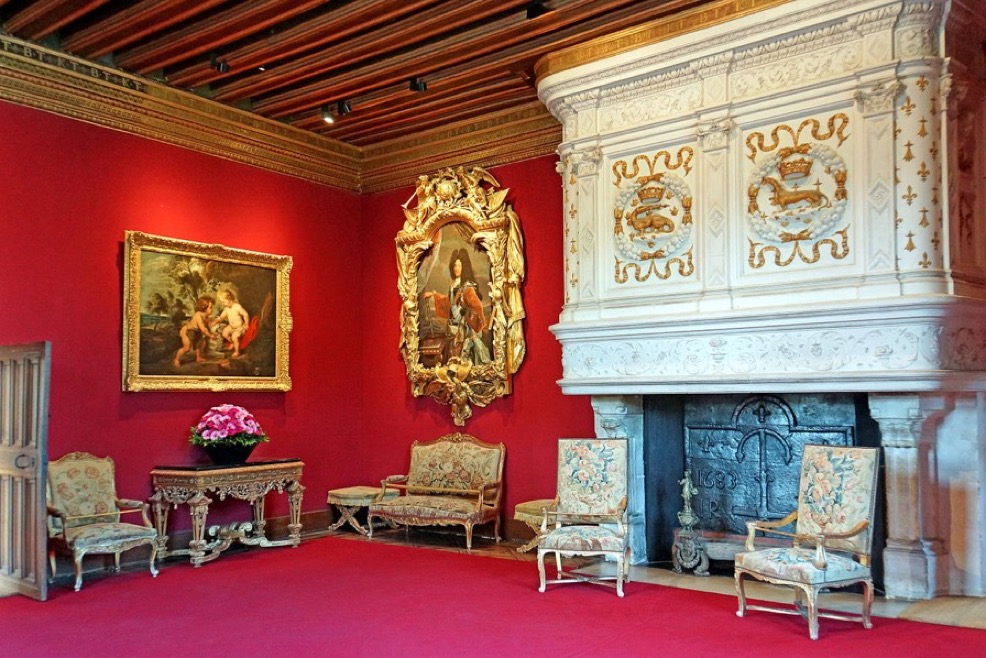
The massive chimney is decorated with the salamander, symbol of François 1er, and the ermine, symbol of his wife the Reine Claude (1499-1524).

And hanging next to the chimney we have a portrait of Louis XIV, painted by Hyacinthe Rigaud in 1700. This is very reminiscent of his famous 'Roi-Soleil' coronation portrait of 1701 that now hangs in the Louvre. The gilded wooden frame is typically Rococo, and is made of just four pieces of wood.
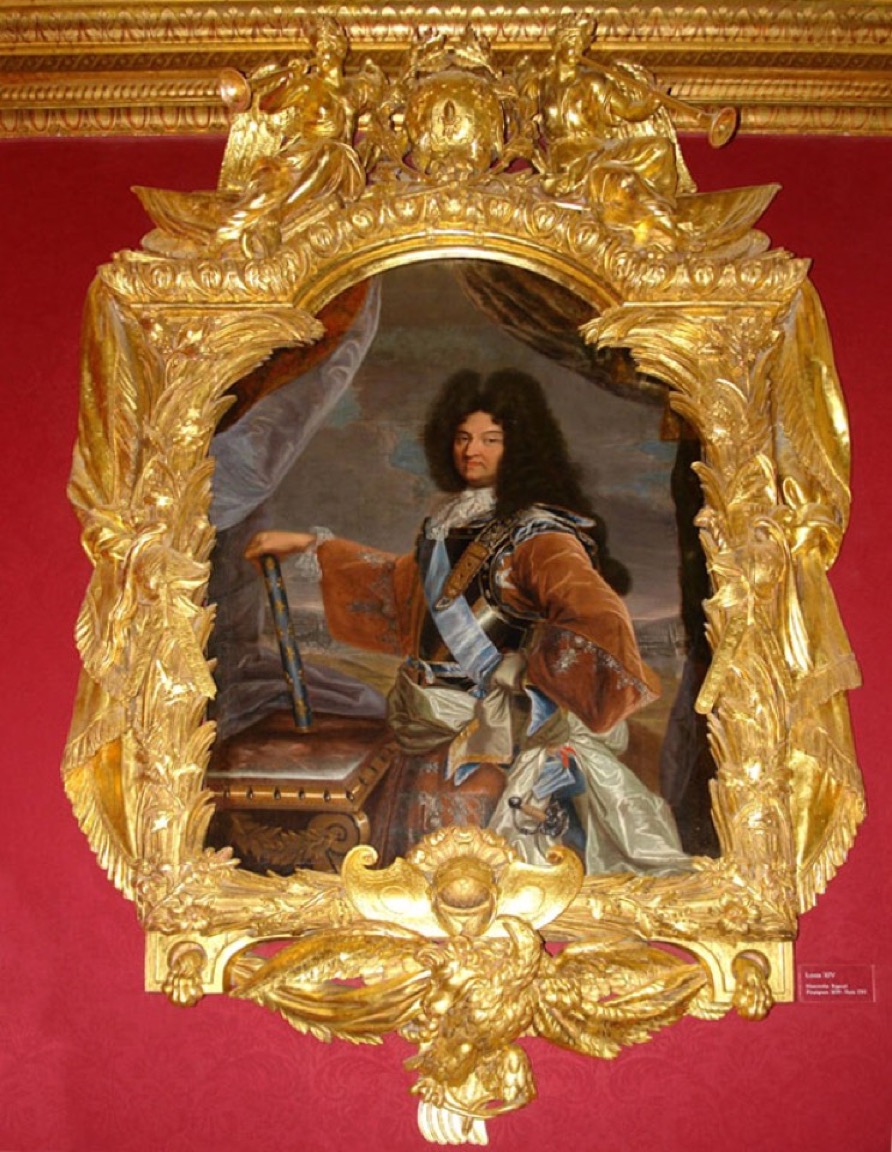
And now down to the kitchens
We know that Katherine Briçonnet wanted large, brightly light kitchens, and we also know that Catherine de Médicis loved entertaining on a vast scale. It is said that one banquet in 1577 cost 100,000 livres, or about €10,000 in todays money. So our expectations are high.
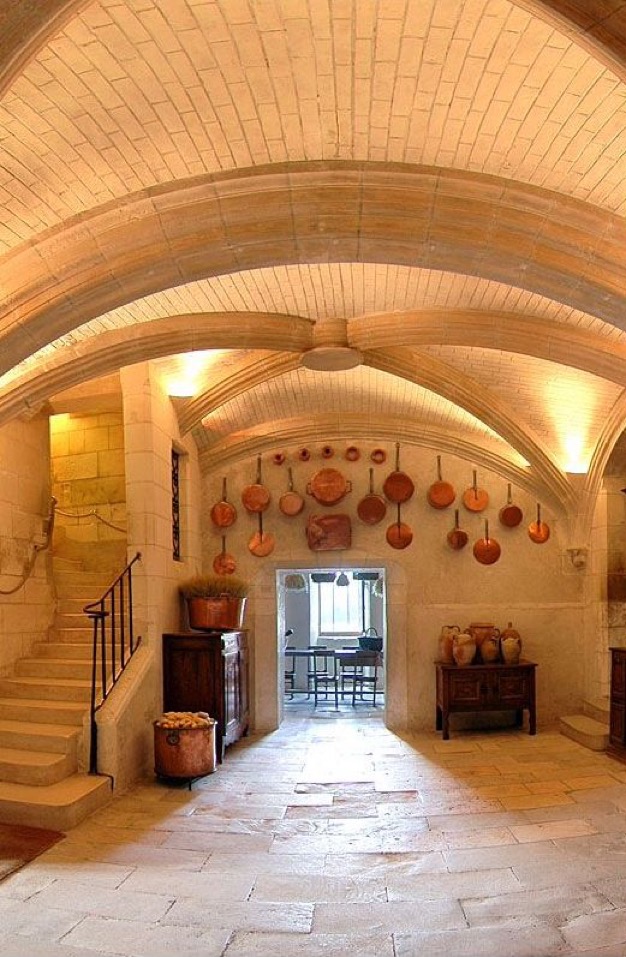
In fact the kitchens in the château are some of the best and most beautiful Renaissance kitchens still existing today. They are accessed by a service stair at the side of the Salon François 1er and are built into the footings of the original water mill. There is a main kitchen, a dining room for staff, and store rooms for wood, meat, etc. They say that food was delivered by boat and so could be delivered at all times of the day and night.

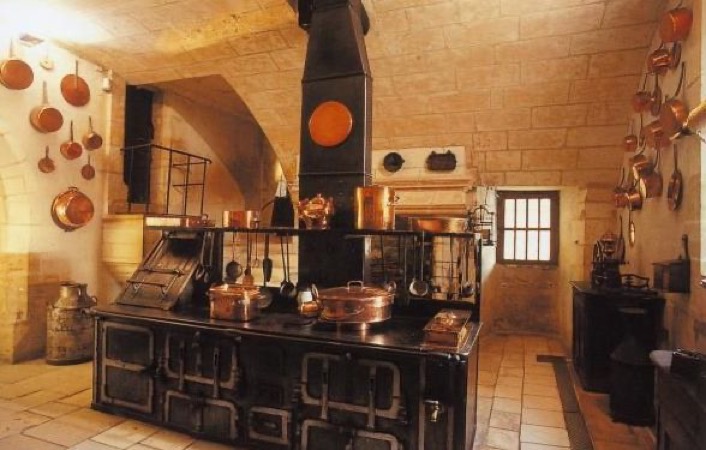
It must be said that a lot of the original installations were replaced during WW I when the château was a military hospital. However I was intrigued by a pulley system for the open fire spit which was driven by a weight hanging down the outside wall over the river.
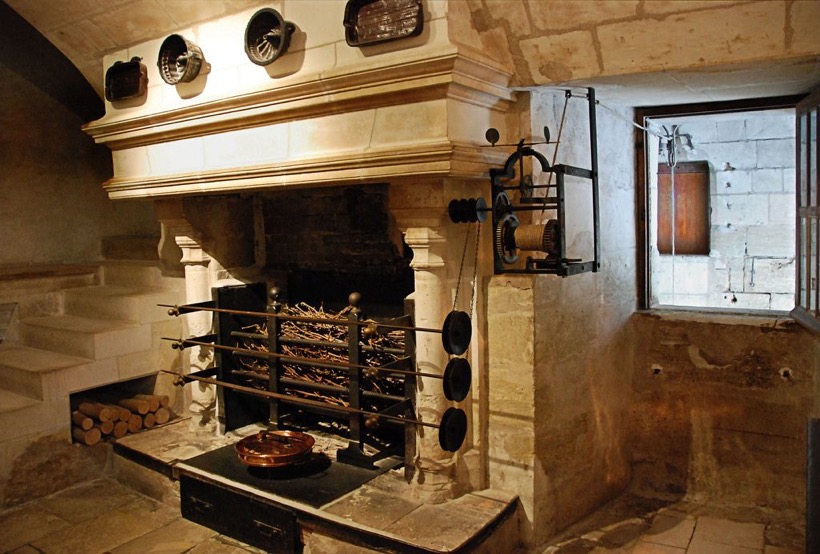
Putting the kitchen in the old foundations and next to the river was very sensible since kitchen fires were a constant threat at the time, and equally given that heat rises it helped heat what would otherwise have been a cold and damp building.
I have read that also in the original foundations of the château can be found a prison, the Bains de la Reine, the boulangerie, and other rooms. It is also said that Diane de Poitiers asked for a secret door that would allow her to access a platform where she could take her daily swim in the river (I presume this refers to the Bains de la Reine). She was renowned for remaining young and beautiful beyond her age, and many say this was due to the fact that she took to the river (i.e. washed) every morning. They say that washing helped her avoid skin illnesses which were common at that time. In fact at that time it was thought that illnesses were carried by water, and that washing and water was 'bad for you'. It must also be said that she ate frugally and rode every day. Finally the story goes that she also drank a solution of gold dissolved in acid and alcohol. The idea was that gold was inalterable and that it could transmit this 'power' to whoever drank an elixir of gold. This story continues in that Diane was buried in Château d'Ante, but her remains were disturbed during the French Revolution. In 2008 tests were performed on some remains still in a local burial site, confirming that they were of Diane and two of her grandchildren. They also found that the gold content in the bones was more than 250 times higher than normal (another report talks of a sample of hair and not bone). The remains were reburied.
La Grande Galerie
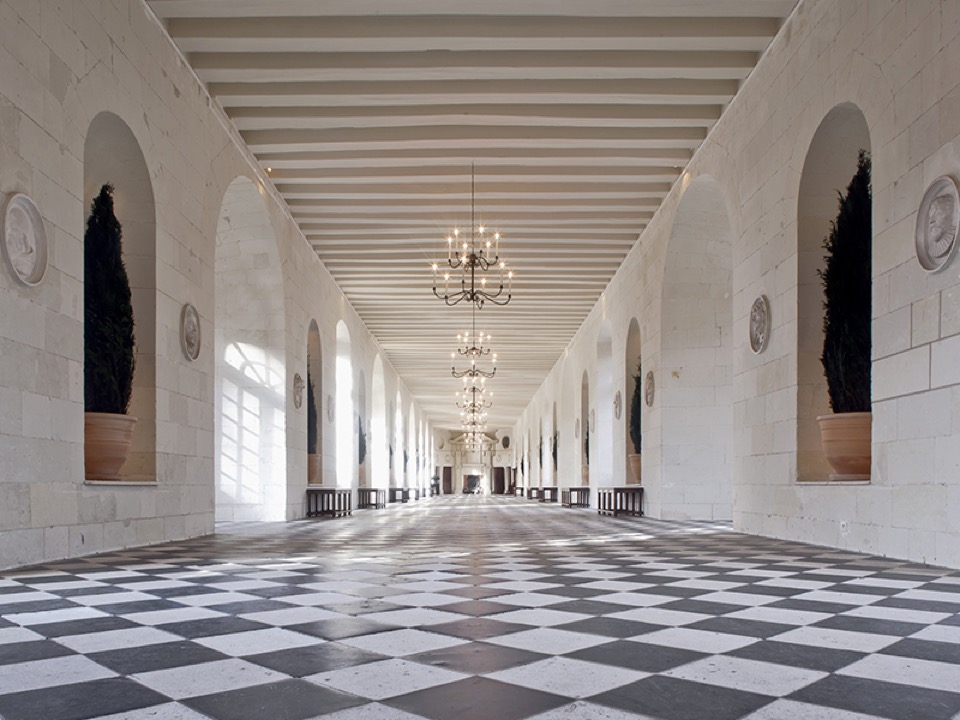
Before we go upstairs we must visit La Grande Galerie, and this means introducing our third lady of Chenonceau, Catherine de Médicis (1519-1589). We have already heard that she, upon the death of her husband Henri II, took control of Chenonceau. She hosted in Chenonceau the celebration in honour of her son, the young François II (1544-1560) and his new wife Marie Stuart. The young king died that same year, and Catherine de Médicis became Regent (and Queen Mother) for Charles IX (1550-1574) who was only 10 years old.
Catherine de Médicis
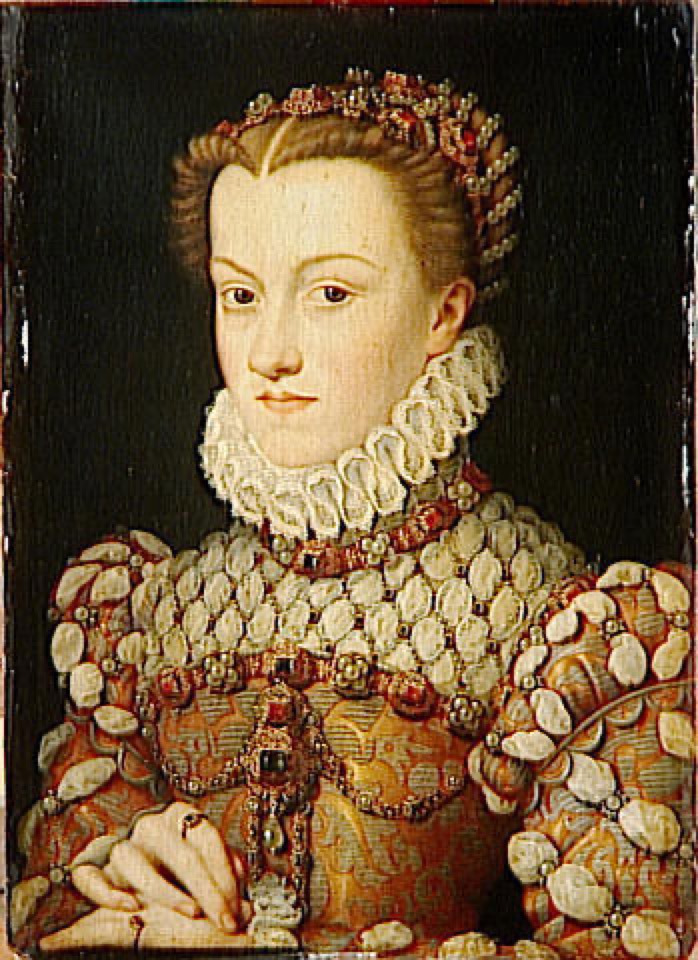
Catherine de Médicis decided to extend and embellish Chenonceau. Firstly she created Catherine’s Garden (seen below), but the central fountain was only added in 1984. Next to it she created the 'Green Garden', which is now an enclosed lawn surrounded by trees providing excellent shade in the summer months.

Catherine had great plans to extend the château, but first we must return for a moment to Diane de Poitiers. During her time in Chenonceau she also had built an impressive extension to the château. During the years 1556-1559, and for a price of 9,000 livres, she had built a bridge from the château to the other side of the river. This bridge was not a new idea, it had been in the original plans of Bohier, but now the objective was to provide access to new gardens and the vast hunting lands on the other side of the River Cher. It is said that Diane de Poitiers asked Philibert de l'Orme (also written Philibert Delorme) to build a bridge and narrow gallery communicating between two pavilions, one on the other side of the river. Philibert de l'Orme was the foremost architect of the French Renaissance and is known to have supervised the building of Fontainebleau and the Château d'Anet (1552-1559) for Diane de Poitiers. His enduring memorial was his Livre d'architecture, which first appeared in 1567.
Finally at Chenonceau only the bridge was built by Philibert de l'Orme, and what we see today is a wider 2-storey gallery ordered by Catherine de Médicis from the builder and architect Jean Bullant (1515-1578).

Catherine de Médicis, in a stroke of genius, decided to build a two story gallery on top of the bridge. Long 60 meters, wide six meters and with 18 windows it provided two unique reception rooms, one on top of the other.
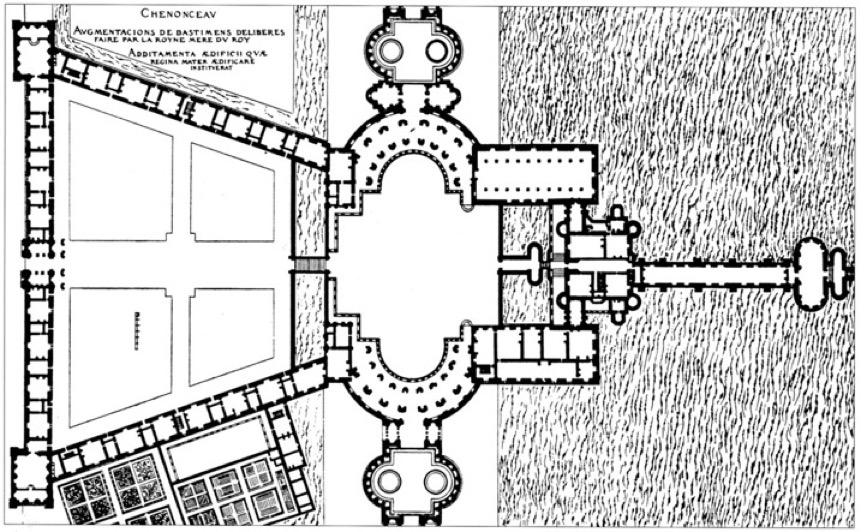
We must remember that the château at that time was quite modest in size (as were many other manor-houses in the region) and it became quite fashionable to build a gallery that would work as both a ballroom and banquet hall. We know that Catherine wanted also to massively extend the château itself but was compelled to abandon her plans because of the exorbitant costs. When we wrote massive, we meant massive. If you look at the above plans the existing chateau is just the little bit on the right.
There is a story about Catherine de Médicis that really does not fit into the context of this page, but nevertheless highlights her intelligence, her forward thinking, and her desire to always impress. It is said that she was as a 14 year old quite small, quite plain, and perhaps a little worried about how she would be received in the French court. The story goes that she had a person with her who transformed her (but we do not know who it was). She became taller and walked with a certain elegance and sensuality. And with her darker, exotic Italian looks she transfixed the French court. It is said that this person was a cobbler who made high-heel shoes for her. Is this a load of cobblers? Who knows. And as a test for the reader, they should look up what “cobblers” actually means in Cockney slang.
La Grande Galerie - again
So back to the 'Grande Galerie' (no.10), a single long room with a floor laid with enamelled tiles of slate and chalk and at each end what were originally impressive Renaissance chimneys.

This extension is more in the later Renaissance style (Mannerist period). Somewhat more sober, we see that the widows have lost their central stone supports, and some windows are now round or oval. In fact curves have appeared everywhere, and we have lost a lot of the classically inspired ornamentation. Some experts call this "unnaturally elegant", but to be honest I don't really know what that means.
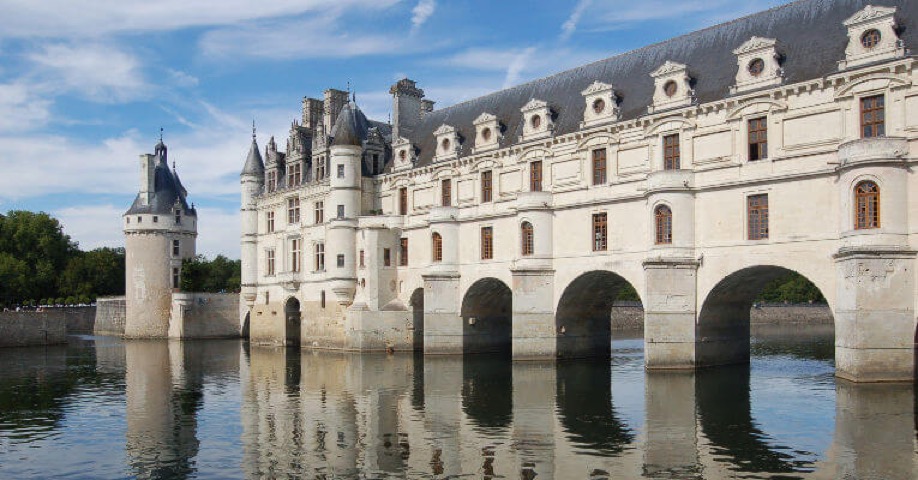
During WW I the 'Grande Galerie' was used as a military hospital where more than 2,200 soldiers were cared for. During WW II the River Cher was the border between the collaborationist Vichy government and Nazi-controlled France. It is said that Chenonceau witnessed many prisoner swaps, and at night château staff would help resistance fighters and Jews cross in secret.
The First Floor
We are now going to visit the first floor, but, as you might expect, we cannot just walk upstairs. Sitting between the Salon François 1er and the Salon de Louis XIV we have an Italian inspired stone staircase (no.8).
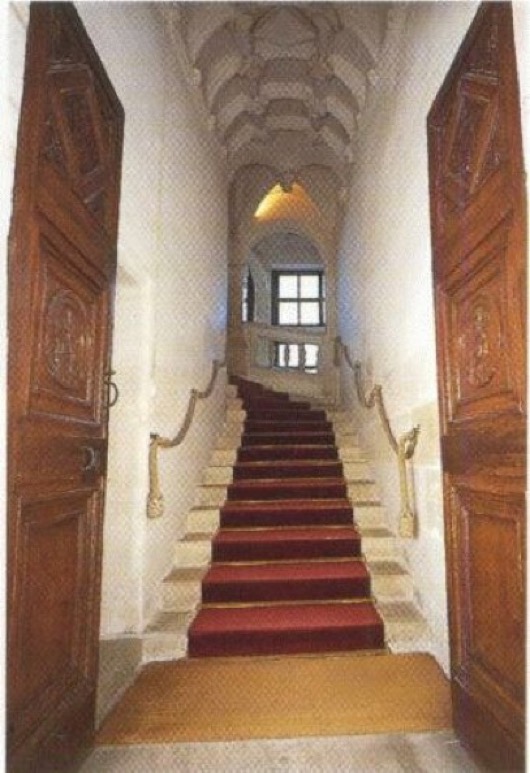

In France the stairs were usually spiral and placed in a corner tower, and it has been suggested that these stairs were the first built in France to the new Italian designs. For many experts these stairs are the most original innovation in the château. They claim that everything is to be admired. How the ribs in the vaulted roof intersect at right angles, how the groins are decorated with keystones, and how the coffers are decorated with human figures, fruits and flowers. I must admit that I quite liked the way the two banisters intersected on a landing forming a loggia with a balustrade. Very effective, since you have a view of the Cher and it lets light into the stair well.
We emerge on the first floor in the so-called 'Vestibule de Katherine Briçonnet' (no.6) decorated with tapestries and classical marble médaillons, and with access to a balcony over the main entrance of the château.

We now have a new floor plan and a new series of rooms to visit. We have the 'Chambre des Cinq-Reines' (no.5) with its access to the tribune in the chapel (no.1), and there is the 'Chambre de Catherine de Médicis' (no.4) with its access to the 'Cabinet d’Estampes' (no.’s 2 and 3). There is the upper floor of the 'Grande Galerie' (no.10), and there is the 'Chambre de César de Vendôme' (no.9) and the 'Chambre de Gabrielle d’Estrées' (no.7).
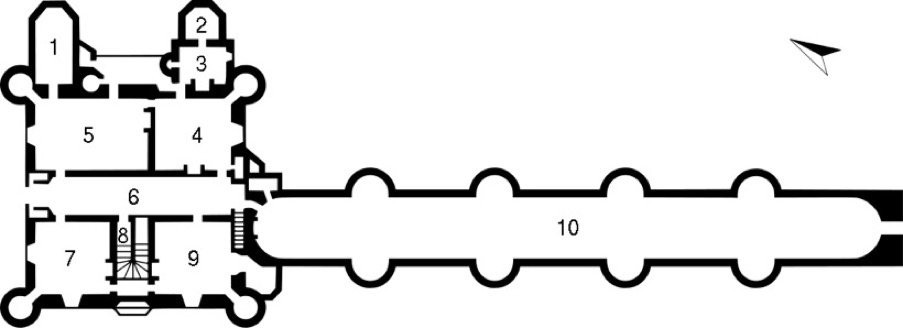
The 'Chambre des Cinq-Reines', or the 'bedroom of the five Queens', (no.5) takes its name from the fact that it was used by the two daughters and three stepdaughters of Catherine de Médicis, namely the Reine Margot (wife of Henri IV), Élisabeth de France (wife of Philip II of Spain), Marie Stuart (wife of François II), Élisabeth d’Autriche (wife of Charles IX) and Louise de Lorraine (wife of Henri III).
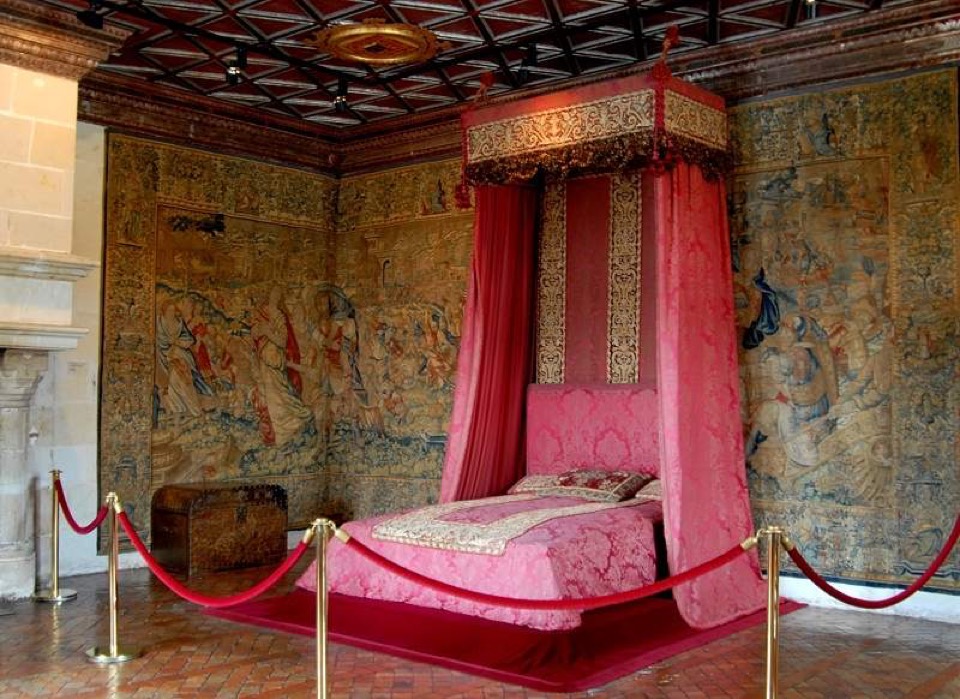
I found this room both quite impressive and quite 'warm' with the rich colours of the painted roof, the 16th century Flemish tapestries, and the browns and oranges of the floor tiles.
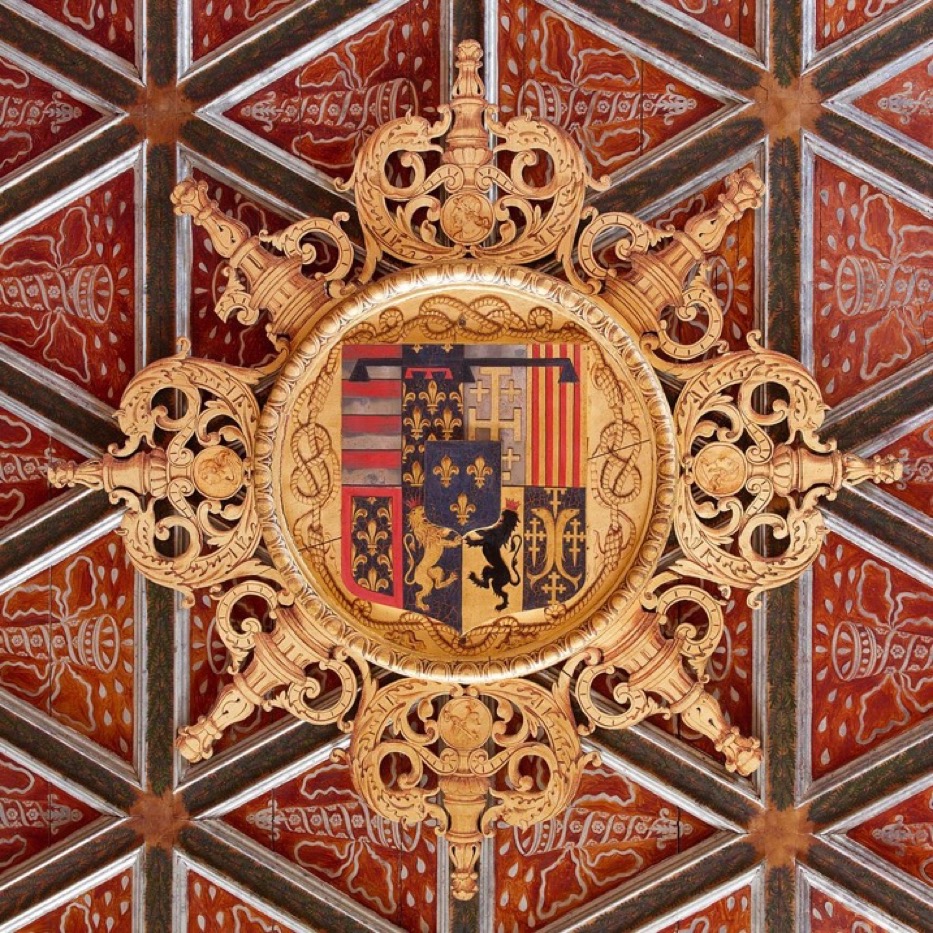
We can see the arms of Louise de Lorraine set in the centre of the ceiling.
Some of the small terra-cotta floor tiles are stamped with the royal 'fleur-de-lis' often associated the French monarchy.
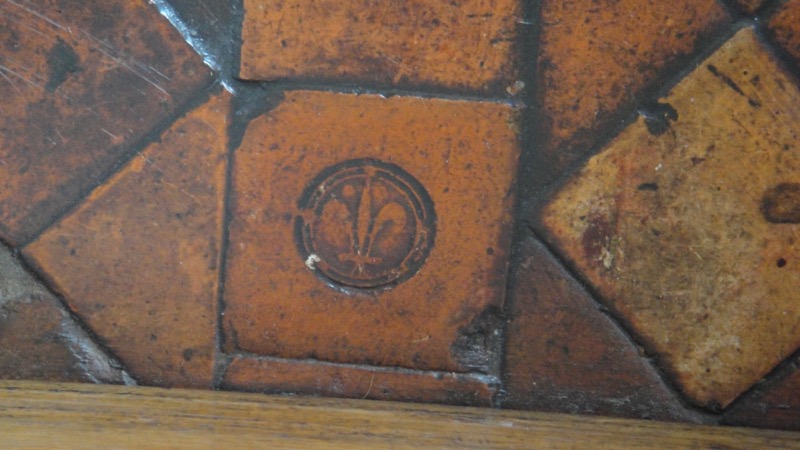
The next room is the famous 'Chambre de Catherine de Médicis' (no.4) again with rich 16th century furnishings and Flemish tapestries. The baldaquin bed is typical for the Renaissance period, made in solid highly decorated oak, it could be disassembled and moved from one château to another. At the time they would have moved the bed along with all the seats, trunks, and tapestries. By the 16th century the bed had also become a statement of wealth and power, and this one radiates power and authority.

Many people comment on the beds being small, and they are often told by guides that until the 19th century people slept sitting up so as not to be mistaken for the dead. The truth is somewhat different. Firstly the beds are in fact not so short, they just look very short because they are narrow and high. Secondly, every bed was hand made and was likely to be a different size. However we also know that the richer medieval person was reasonably tall even by todays standards, e.g. possibly around 165 cm, although the average might have been slightly less than 160 cm. Remembering that most people would not have slept in a bed, and I’m told that people who had beds actually slept with bolsters and pillows so that their head and shoulders were slightly raised (but they were not sitting). There are some historically valid descriptions of people sleeping in this position, but no one appears to know the reason. There are also examples of beds with sloping backs and support for the knees. But the bit about being mistaken for dead is clearly rubbish, because you can just as easily die sitting.
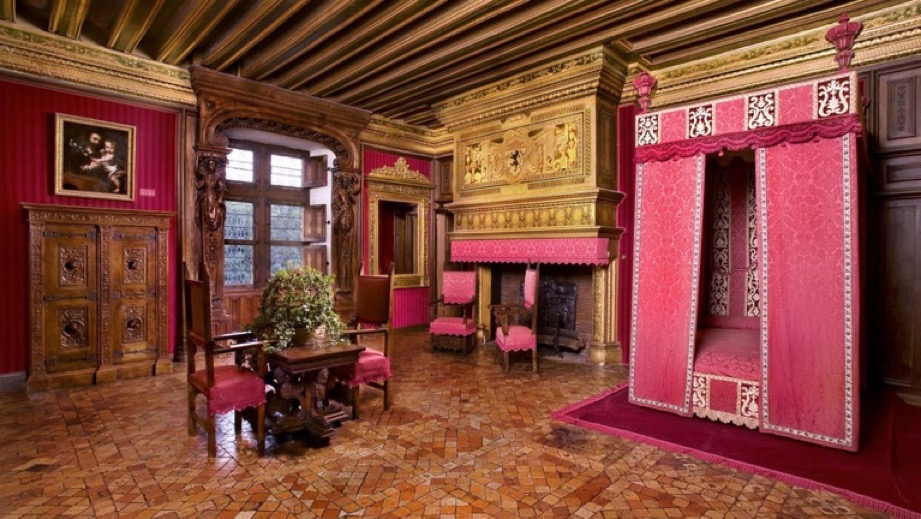
Above we have the 'Chambre de César de Vendôme' (no.9), son of Henri IV with his mistress Gabrielle d’Estrées (César was legitimised in 1595). This César de Vendôme was quite a character since he was imprisoned and exiled several times for plots against the Cardinals Richelieu and Mazarin. But his link to Chenonceau was through the fact that he received it as a present from Louise de Lorraine (1553-1601) when he married her daughter Françoise de Lorraine (1592-1669). Françoise was only 6 years old at the time she was promised for marriage, and she was 16 when she was finally married.

The last bedroom on this floor is the 'Chambre de Gabrielle d’Estrées', who was the mistress of Henri IV of France (1553-1610). She has a bedroom in the château, but never lived there. The story goes that Henri IV received an annulment of his first marriage and planned to marry Gabrielle, but she died a few days later. It is thought she was poisoned. Henri was grief-stricken and gave her a funeral fit for a queen.
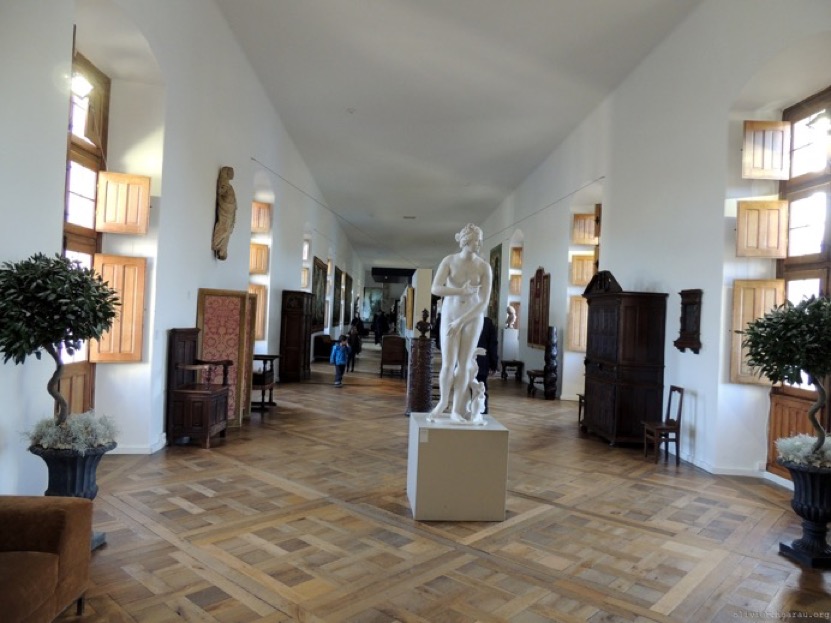
We are nearly finished, but we do have a final room to see on the top floor. Before we do that we should just have a peak at the 'Galerie Haute' or upper gallery (no.10). In the past this was divided up into small rooms, probably for the domestics of the château, but today it is again a single long, very simply decorated gallery. One source mentions that this upper floor might also have been used for guests. During our visit it was hosting a presentation on the 'six women' who had influenced the château during its history. Below we have a 16th century Flemish tapestry from the exhibition. With the greens fading into blues over time, this tapestry looks distinctly modernist.
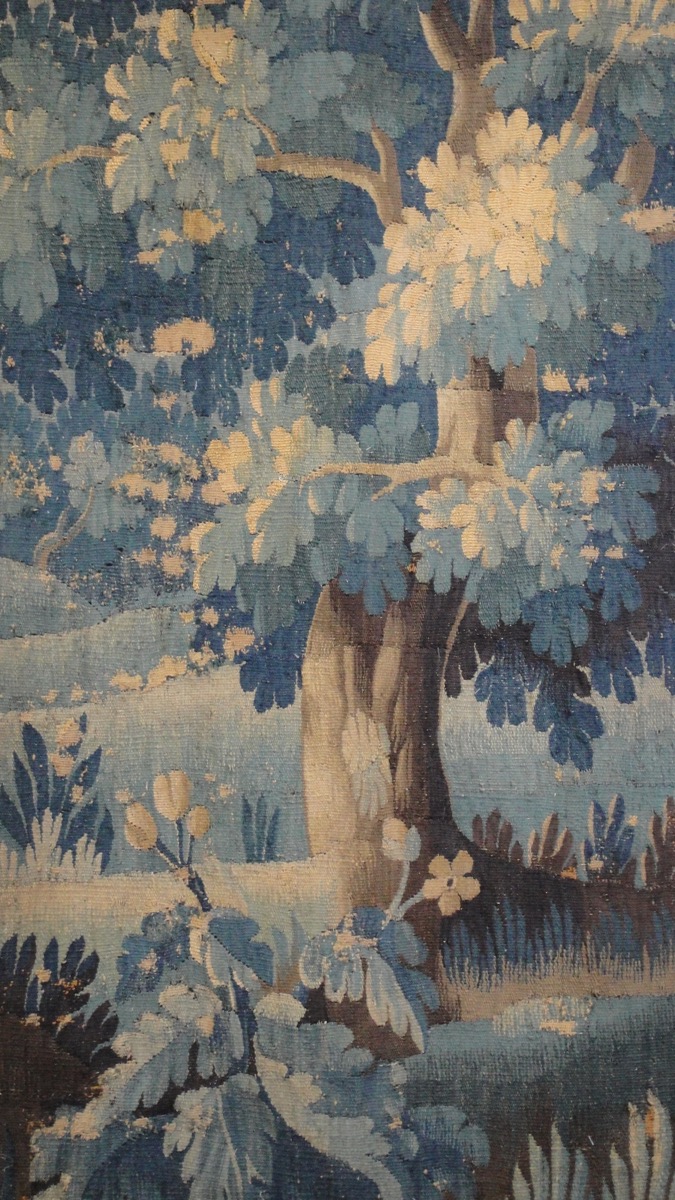
So we are now in the hall on the top floor, largely restored in the 19th century (see below). We are going to visit the 'Chambre de Louise de Lorraine', but before doing so we will talk a little about the fourth woman of the 'six women' of the château.

Louise de Lorraine
Louise de Lorraine (1553-1601) received Chenonceau after the assassination of her husband Henri III (1551-1589). She was overcome by grief, became melancholy and never recovered. Always dressed in white (the royal colour of mourning) she became known as the 'Dame blanche de Chenonceau'. She had her room painted black and decorated with silver tears and crowns of thorns. As they say, darkness fell on Chenonceau. What we see today is a reconstruction, based upon the original decoration of the ceiling.
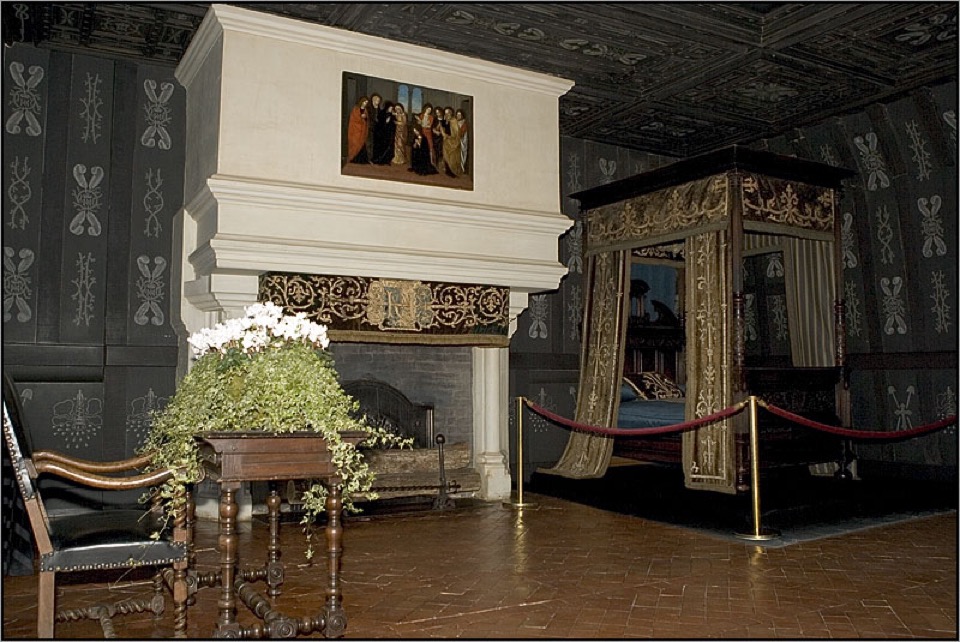
1589 was also the year of the death of Catherine de Médicis, who left debts of more than 800,000 écus (probably near $50 million today). Louis de Lorraine, as the new owner of Chenonceau, was pursued for a debt of 37,600 écus, which she was not able to pay. It was Gabrielle d’Estrées, the 'favorite' of Henri IV, who purchased the debt for 22,000 écus. She later abandoned the debt in favour of Louise de Lorraine, who left the property to César de Vendôme, the 'natural' son of Henri IV. Wikipedia has quite a complete and detailed review of the successive debts on, and owners of, the château. Sufficient to say during many years Chenonceau survived but without managing to recapture its former glory. It was abandoned by the Bourbons, and year by year, the contents of the château were dispersed.
Recent times

In 1733, Claude Dupin (a descendent from the old Berry family) bought the castle from the Duke of Bourbon. His wife (a daughter of a rich financier) Louise Dupin (1706-1799) once again worked to help the château find its former splendour and she reestablished the court life of the castle. It is said that Montesquieu (1689-1755), Voltaire (1694-1778) and Rousseau (1712-1778) were frequent visitors to Chenonceau. Rousseau actually wrote that he became "as fat as a monk" whilst staying at Chenonceau.
In 1864, Théophile-Jules Pelouze, famous chemist, bought Chenonceau from the heirs of Madame Dupin for 850,000 francs. Marguerite Wilson (often known as Madame Pelouze) was the sixth and last woman, and she began restoration work on Chenonceau that would last ten years. It is she who tried to give the château the appearance it might have had in the early 16th C. As such many of the alterations carried out by Catherine de Medicis were thus destroyed.
In 1913 the château was purchased by a rich manufacturer, Henri Menier, the grandson of the founders of a chocolate firm of the same name. The estate of Chenonceau has since that date stayed in the same family. In 1952, they entrusted a young agronomist, Bernard Voisin, with the preservation of the castle, which was then in a miserable condition. The ravages of time as well as mans neglectfulness had left the buildings, the roofs and the gardens in a dilapidated state. But the enthusiasm of Bernard Voisin payed dividends. He successfully refurbished the castle and its numerous outbuildings, protecting them from the rain, and managed to restore the beauty and the prosperity of the gardens and the surrounding vineyards. Little by little, Chenonceau was given a new lease of life. It could now be open to the public, bearing witness to five centuries of history and culture. In 2001, Chenonceau fully recovered its glory, and now with its one million visitors every year it is said to be, with the exception of the Palace of Versailles, the most visited castle in France. This is in clear contradiction with visitor figures provided by the regions tourist authorities! Who knows?